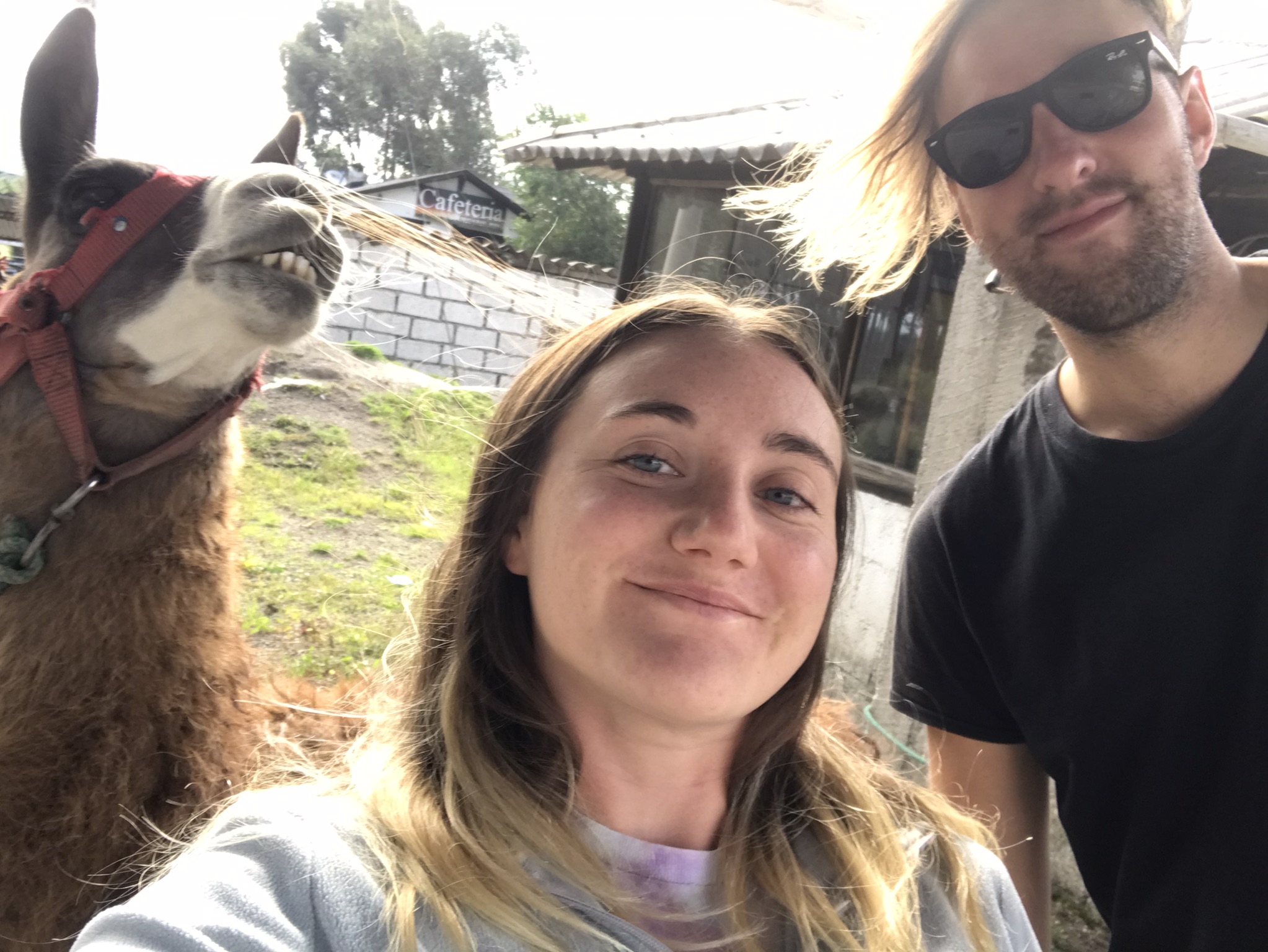We had very mixed feelings when it came to Costa Rica. We were blown away by the natural beauty of the country with its pristine rainforest and exotic animals hiding in plain sight. We weren’t so thrilled with the onslaught of international tourists with more money than sense, the theme-park vibe to some of the places we visited and non-stop promotion of over-priced tours and activities. The streets of La Fortuna are a prime example of this, tour agency offices fight for space amongst the horde of souvenir shops surrounding the main square. It’s hard to find authentic local culture in a place swamped by an ever-changing carousel of foreigners, where everyone is trying to sell you something and tipping is expected. Costa Rica is also a very expensive country and difficult to travel on a budget. Check out my blog post on how to save money in Costa Rica, and check out my Costa Rica budget travel experiences below!
San Jose, La Fortuna, Monteverde, Quepos – Manuel Antonio, Palmar Sur
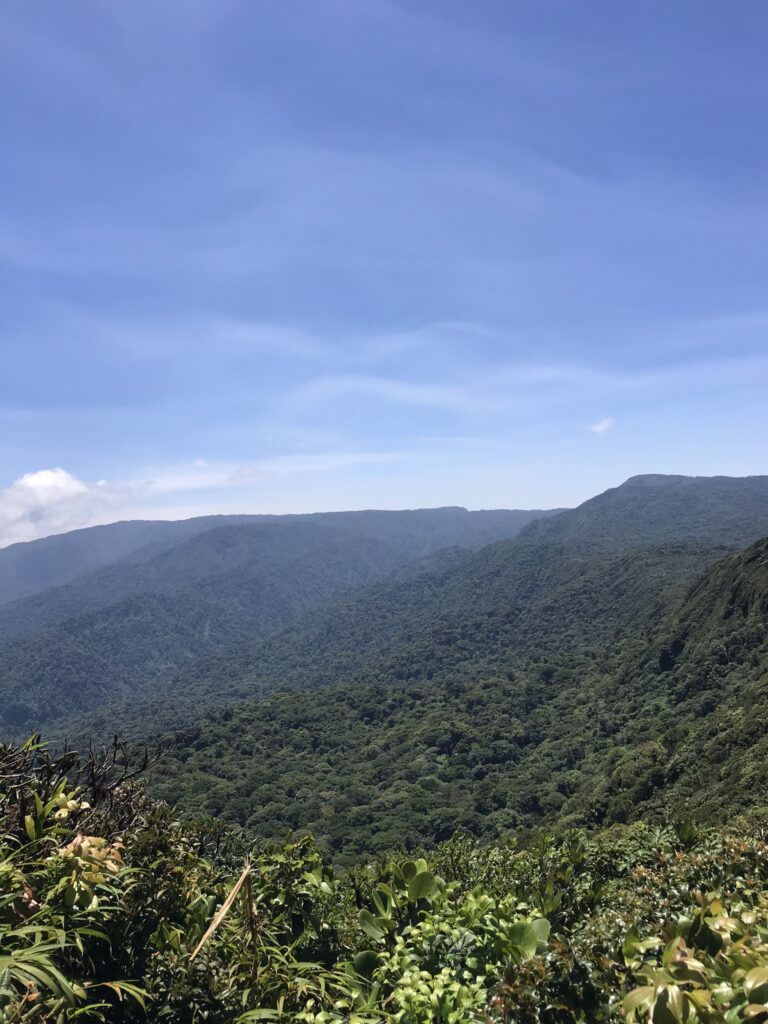
The terrific view at Monteverde Cloud Forest Biological Preserve
After a frankly awful border crossing, we finally made it into Costa Rica sweaty, overheated and stressed-out. It turns out having proof of onward travel is non-negotiable in order to enter the country. Since we were heading by chicken bus to Panama and so didn’t have a plane or bus ticket booked out of the country we had to spend two frenzied hours at the immigration office trying to find a way without wifi or loads of cash (the cash machine ran out of dollars – wonderful!) to book a flight out of the country.
In the end, a Swiss backpacker took pity on us and let us use her mobile data. We are usually so careful to research exactly what we need to have to cross borders, we decided to chance it this time and found out the hard way. If you’re flying out of Costa Rica, you’ll have no problem as long as you can show proof of your flight. If you happen to find yourself in the same boat as us, don’t panic, there are unofficial ways available to backpackers to buy proof of onward travel just so you can get through immigration. If you’re not sure exactly when you plan on leaving you can use a website such as this one. This company and others like it book a legitimate flight for you, send you the flight ticket and then cancel the booking on your behalf. This service saved our asses at the border and only cost about $25 for two fake tickets.
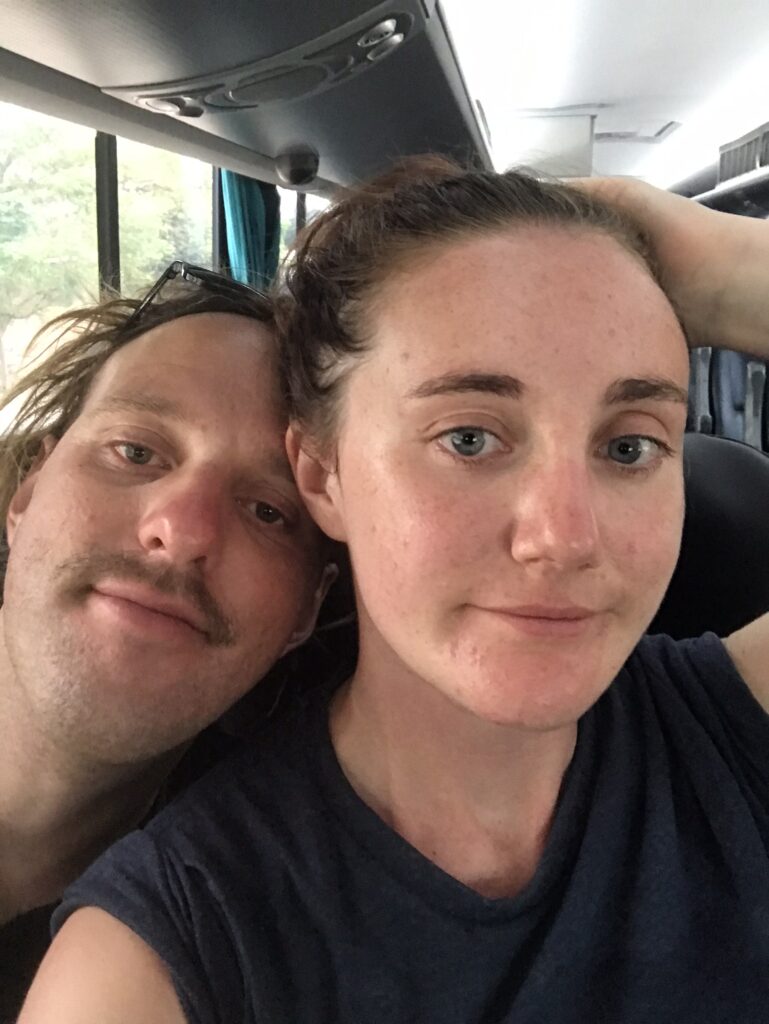
Breathing a sigh of relief on the bus after our ordeal at the border
Costa Rica’s main industries are tourism, cattle ranching and coffee cultivation. National parks make up around 25% of Costa Rica’s land mass, this means less land for farming crops. This has a knock-on effect for Costa Ricans who, in general, have to pay much higher prices for essential products due to the majority of products needing to be imported. Heavy import taxes cause even greater price leaps. All of this isn’t ideal for backpackers on a budget.
Costa Rica is expensive, don’t listen to other ‘backpacker-type’ bloggers who claim it’s not. Whether you choose to eat out at Sodas (these are cheaper, family-run restaurants) or decide to cook your own food, you will inevitably be shocked by food, accommodation and activity prices. In a supermarket in Monteverde I paid $6 for some regular mushrooms and $6 for some parmesan cheese, in hindsight not my best budgeting decisions. Sadly these sorts of prices are standard across the country. Unfortunately, Costa Rica is a place where wealthy tourists can live it up like kings but us backpackers can only afford to live like beggars. Backpacking in Costa Rica is a balancing act between getting the most from each destination and trying to keep costs down. It’s incredibly difficult! At times you just have to bite the bullet and fork out for unmissable experiences.
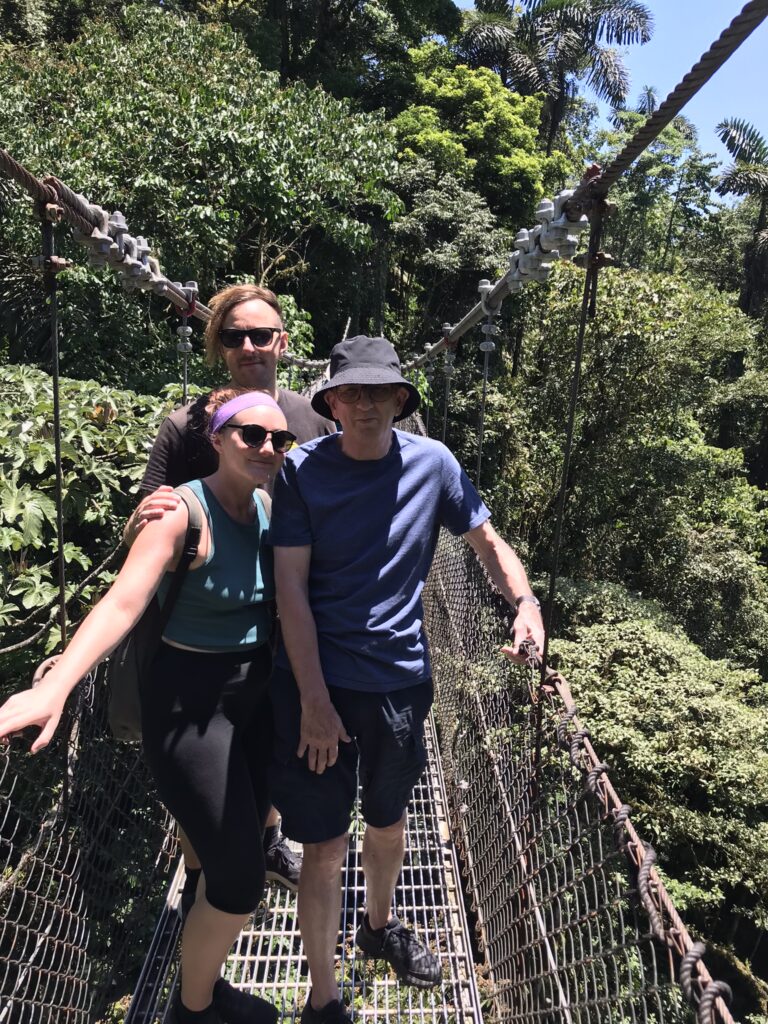
Hanging out at Mistico Hanging Bridges
Alongside the high cost of living in Costa Rica, other current issues include the proliferation of foreign investment in property, resorts and businesses. The problem with this being that all profits are then funnelled into non-Costa Rican hands, failing to benefit the community or local people and instead going straight into the pockets of foreign fat cats.
I found it fascinating to learn how local landowners have increasingly changed their business model from cattle-ranching to ecotourism. Letting their land naturally return to rainforest, termed secondary forest, and opening it to the public in an environmentally conscious way. Choosing the path of conservation as opposed to exploitation to boost their finances. Mistico Hanging Bridges, El Silencio, Bogarin Sloth Trail and Monteverde Cloud Forest are all examples of ranching land transformed into tourism projects that we visited. The dichotomy wasn’t lost on us.
Due to the high prices we mainly cooked our own meals in Costa Rica, which was still quite expensive. Our few meals out were mostly at Sodas, family-run restaurants with cheaper prices (although still more expensive than a normal restaurant in neighbouring countries). Another controversial opinion is that we found the food in Sodas bland, not very fresh and of poor quality at times. At one Soda in particular I was convinced they’d used instant noodles instead of pasta in a carbonara. Yuck!
Travel Advice
Don’t go to the Nicaragua – Costa Rica border without having proof of onward travel. Buy your bus or plane ticket in advance; learn from our mistakes. Heed my advice!
Another very important point to mention is that to get the best deals on accommodation you need to book in advance, especially during high season. We booked all our accommodation about a month in advance and managed to bag some cheap, highly-rated places. If you leave booking to the last minute, you’ll end up with fewer, more expensive options.
Book your park tickets well in advance to avoid disappointment as there are only a limited number of people allowed into most private and national parks each day. Official guided tours also sell out quickly for some parks at certain times of the year so be sure to reserve your spot beforehand. We saw this first-hand at Monteverde Cloud Forest, two tourists turned up without a ticket and had to wait 3 hours before they could enter the park. Don’t be like them! Plan ahead.
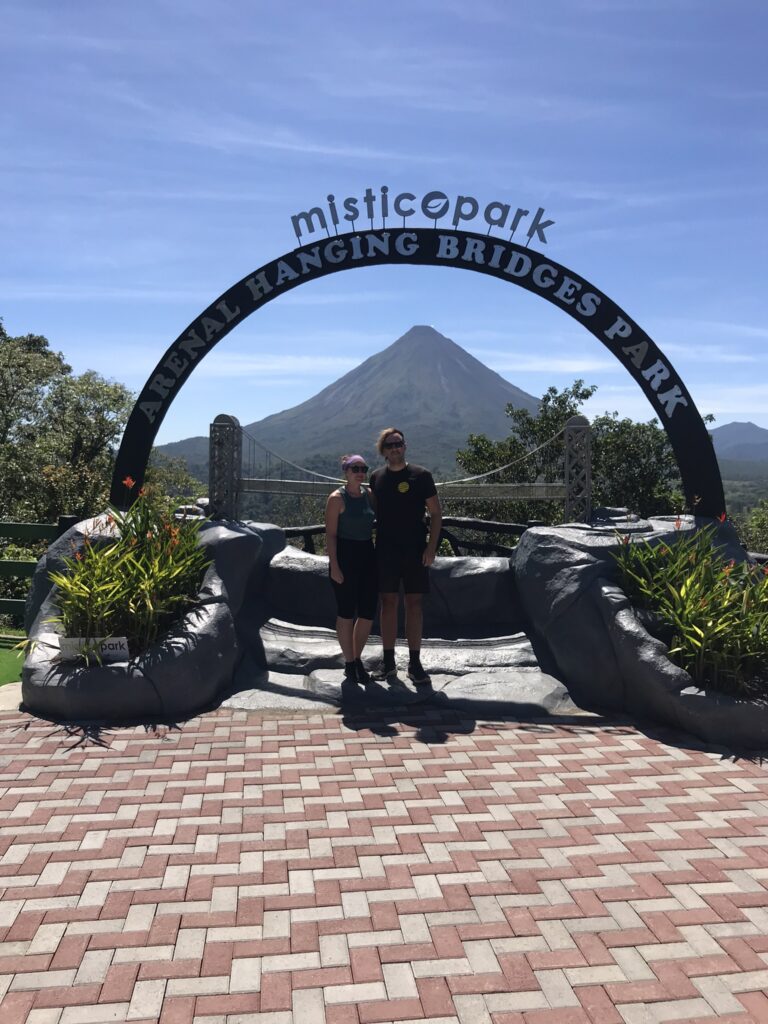
Mistico Hanging Bridges is a must-see place when visiting La Fortuna
Wherever possible book a guided tour through the official park website or at the same place you book your tickets. If that’s not possible, the next best option is to use Viator or another third party website to book a guide for the park. Bear in mind that if you book the guide separately from your ticket you might still have to pay the entrance fee on top of the guides fee. This can work out to be more expensive.
Wherever there are tourists, inevitably there will be scammers nearby looking to make a quick buck from their naivety. If someone offers their guiding services at the entrance to a park just ignore them; these individuals may not be licensed to guide and may try to charge you more than was originally agreed. We personally witnessed this at Manuel Antonio Park. They may also try to sell you overpriced or fake tickets to the park, and may not properly respect the wildlife (such as shining laser pens or shouting at the animals to make them turn around, again we witnessed this first-hand). Always book your guide and tickets in advance and go through the official channels. You don’t want to be at the mercy of these hustlers.
Should I get a guide?
It’s tempting to book park tickets and bypass paying for a guide; however you should really consider whether it’s the best option. I hate to admit it but you do get more out of having a guide, we especially found this to be the case at places like at Monteverde Cloud Forest, Santa Elena Reserve and Mistico Hanging Bridges. We personally saw many animals such as sloths, basilisks, the famous quetzal, a pygmy frog, tarantula, armadillo, stick insect and snake that we wouldn’t have been able to see without a guide pointing it out. Without a guide it’s easy to miss animals as they tend to be camouflaged or high up in the canopy, particularly monkeys, birds and sloths.
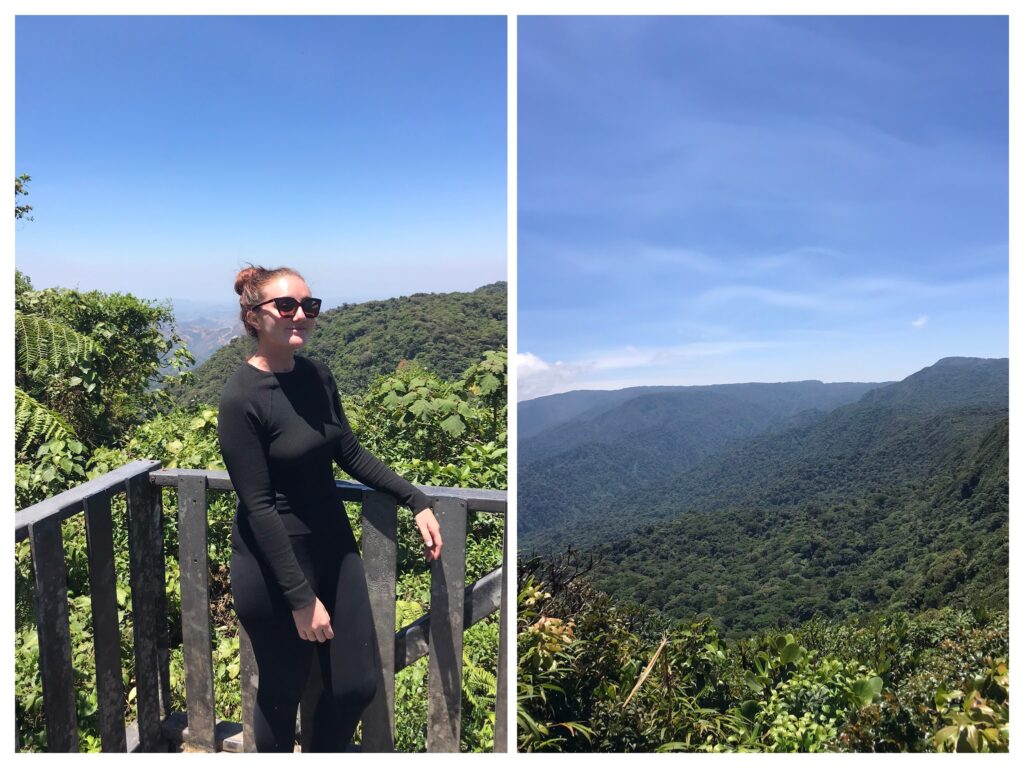
Walking around Monteverde Cloud Forest Biological Preserve after the end of our guided tour
Alongside their knowledge of zoology and botany, the guides usually carry a telescope which allows you to take a closer look at any creatures you spot. It’s challenging to see some of the animals high up in the trees without one, so having a guide and a telescope is ideal.
Guides seem to have a strict code of conduct which means they tip each other off when they spot an animal or bird on the trails. This means that there’s a whole network of guides on the hunt for tropical creatures and you’re much more likely to spot must-see animals and birds than if trying to do it yourself. Guides know the parks like the back of their hand and know where certain animals are likely to be spotted at certain times of the day or year. Their expertise at spotting animals is invaluable, some are almost invisible to the naked eye or can only be found if you know what you’re looking for. If you’re not with a guide then they probably won’t help you or point anything out. Don’t expect them to be helpful or friendly if you aren’t part of a group – it’s a business after all, you’re not paying for their services and tourists in their group are.
If your money can’t stretch to a guide, is it possible to walk around the parks independently though seeing animals is not guaranteed and you might not get the most out of your experience. Equally, you may get lucky and spot loads of exotic creatures, as we did in Manuel Antonio park – we managed to spot White-faced Capuchin monkeys, Howler monkeys, a green rainforest frog, a sloth, two toucans and a very timid deer without a guide, just by sneaking a peak at what other large tour groups were stopping to look at. This method is slightly more sneaky and importantly, if you’re caught by a guide could lead to an awkward interaction. You also won’t be able to look in the guides’ telescopes, of course.
San Jose
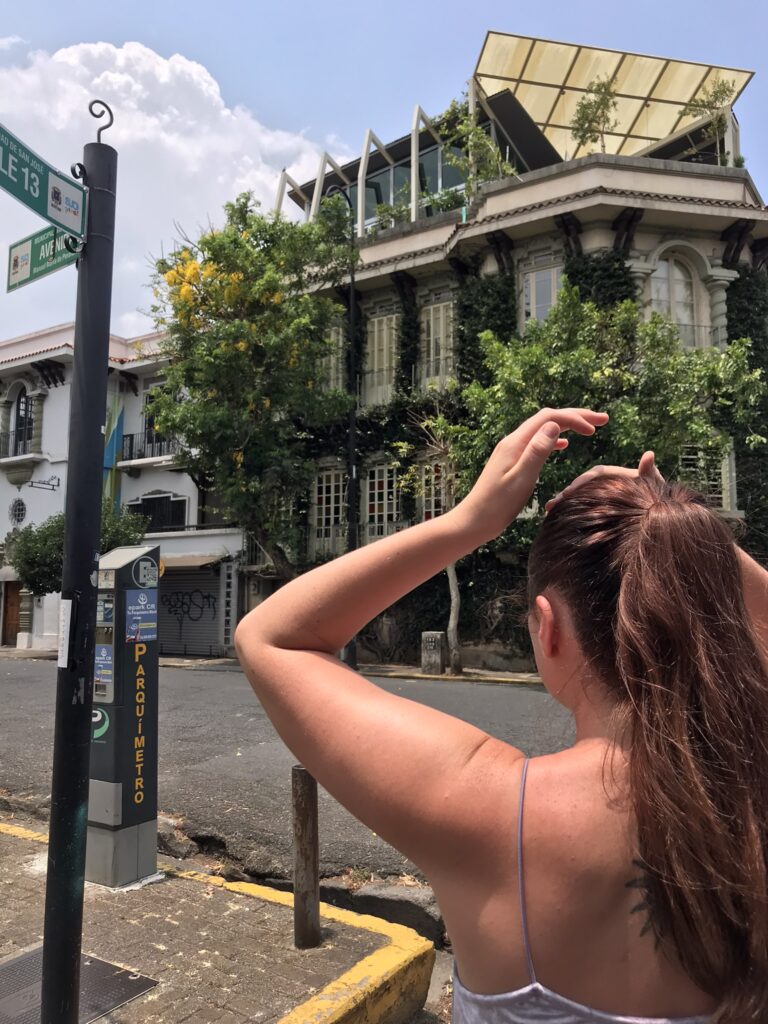
Admiring the beautiful architecture in Barrio Amon
Our first introduction to San Jose was one I’d rather not repeat. After the hairy border crossing, we landed in the capital after a long bus ride from the border. We were then unceremoniously dumped in a less-than-desirable neighborhood, after nightfall, at a very obviously closed bus terminal without a public wifi network available. After wandering the deserted streets in search of a McDonalds and free wifi, we gave up and jumped in a cab. This was the first time we’d arrived at a bus terminal to find out there wasn’t free wifi and it just so happened to be after a stressful border crossing.
Nowhere is the wealth divide more obvious than in San Jose. Abject poverty is never far away. The modern metropolitan city is home to wealthy professionals alongside some of the poorest in society. The destitute walk the streets around Central Avenue. It’s impossible not to see the gulf between rich and poor.
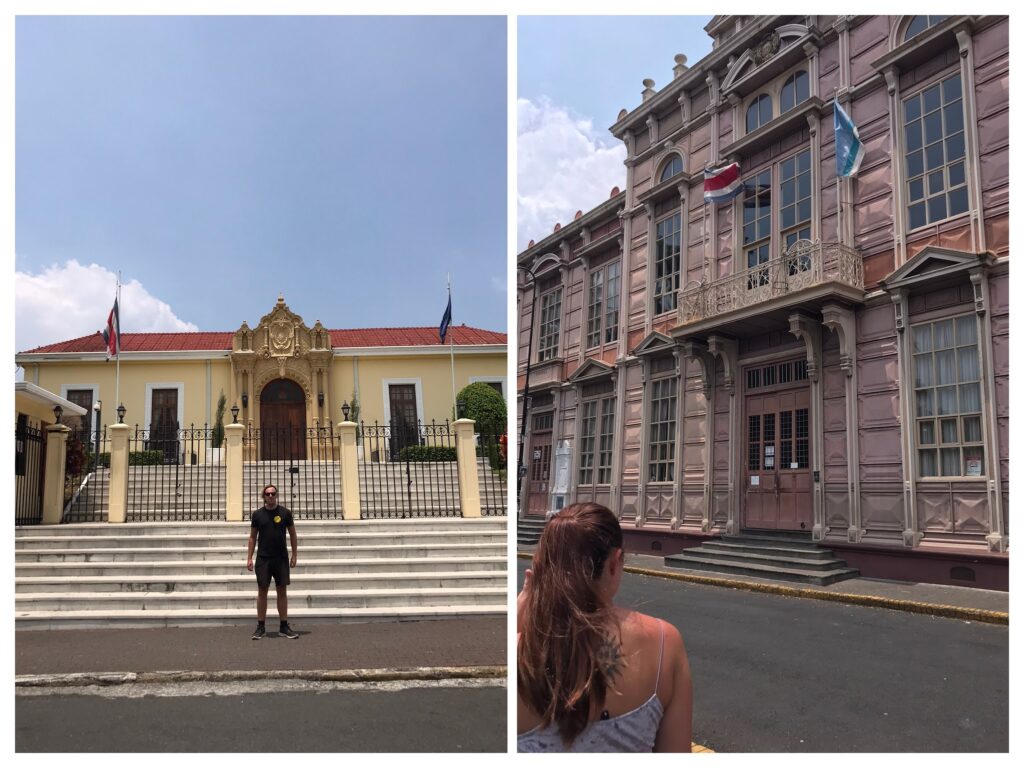
Sightseeing in San Jose
It’s interesting to observe that San Jose doesn’t have many historic buildings and almost none from before the late 19th century. Costa Rica, as a Spanish colony, was mostly ignored by the Spanish Conquistadors. It wasn’t exploited and occupied to the same extent as other Spanish colonies. The wealthy aristocratic class was relatively small compared to other colonial cities with limited grand building works. However this all changed in the early 20th century with the advent of the coffee boom which economically remolded the country into a leading coffee producing country and created many rich landowners. Many grand buildings were constructed with coffee profits transforming the city into what it is today.
Accommodation
Cando Living Apartments – perfect central location, opposite the Jade Museum, close to all the attractions in San Jose. The building itself is very secure, with two separate doors and 24 hour reception. The rental units are clean and modern and stocked with everything you need for a short stay. The units open out onto a central courtyard garden which is a nice touch, offering a safe haven in the middle of the busy city. The price was very good for the facilities and location.
Foodie Places
Café inside Hotel Cultura Plaza – Casado (combo plate) is the thing to try here; you’ll find Casado on almost any menu in high-end restaurants and more budget-friendly Sodas. Pick either pork, chicken or beef to accompany your rice, black beans, plantain (sometimes) and salad. We stumbled into this café after our walking tour and instantly liked the lack of pretense. Plus the waitress didn’t try to speak to us in English which was a clear sign that it was a local place as opposed to the normal tourist guff.
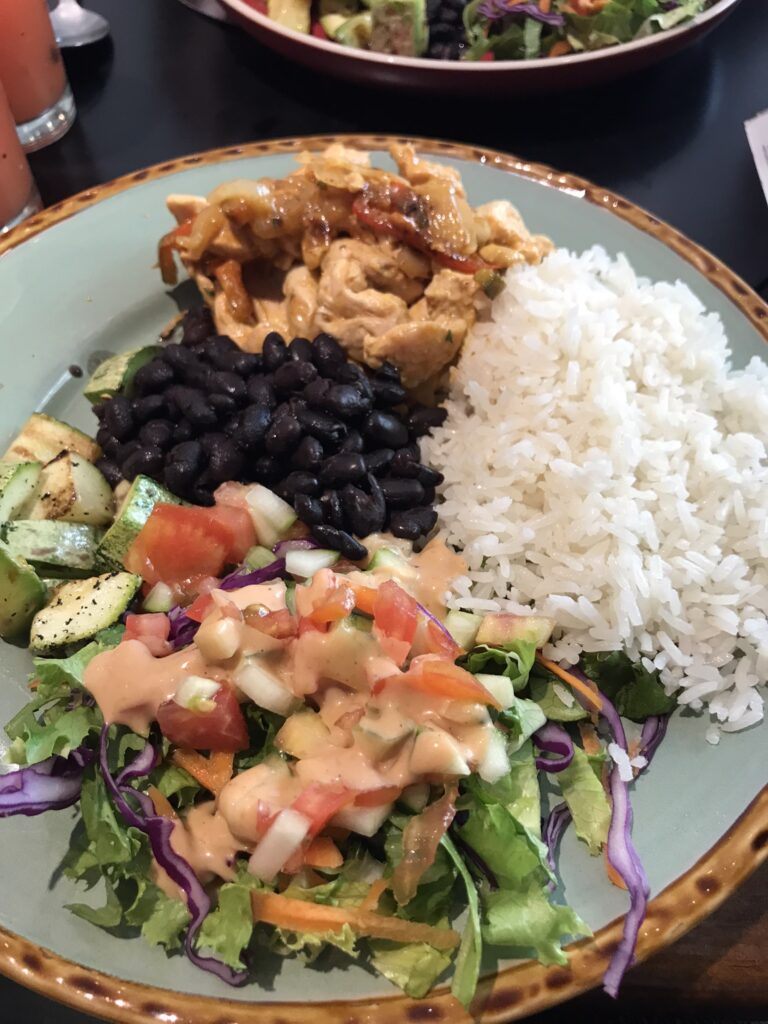
Our first introduction to casado at Hotel Cultura Plaza
El Lobo Mestizo – offers a wide variety of latino food including baleadas from Honduras, pupusas from El Salvador, typical Costa Rican fare and popular Mexican classics.
Panadería Colombiana – a great place to grab baked goods for lunch or long bus journeys.
Activities
Guruwalk ‘Welcome to Costa Rica!! Historical and Cultural Walking Tour’ with Jules, we particularly enjoyed the free fruit and coconut provided by Jules, the Guruwalk host. Jules spoke with an American accent having lived in the US for many years so it was easy to communicate and ask more complex questions. Stops included the Jade and National Museum, the National Theatre with its impressive marble entrance hall, neoclassical sculptures and renaissance-inspired painted ceilings, a typical Fruteria with an introduction to local Costa Rican fruits, Iglesia Nuestra Señora de la Soledad and nearby statue of John Lenon? The Legislative Assembly of Costa Rica, Mexican Embassy, Casa Amarilla or Yellow House, a quirky yellow mansion used to welcome foreign delegates, School Buenaventura Corrales, an interesting pink corrugated metal building. Barrio Amon is known for its collection of impressive mansions built by coffee barons in the early 20th century and is a great place to admire the architecture of these grand houses.
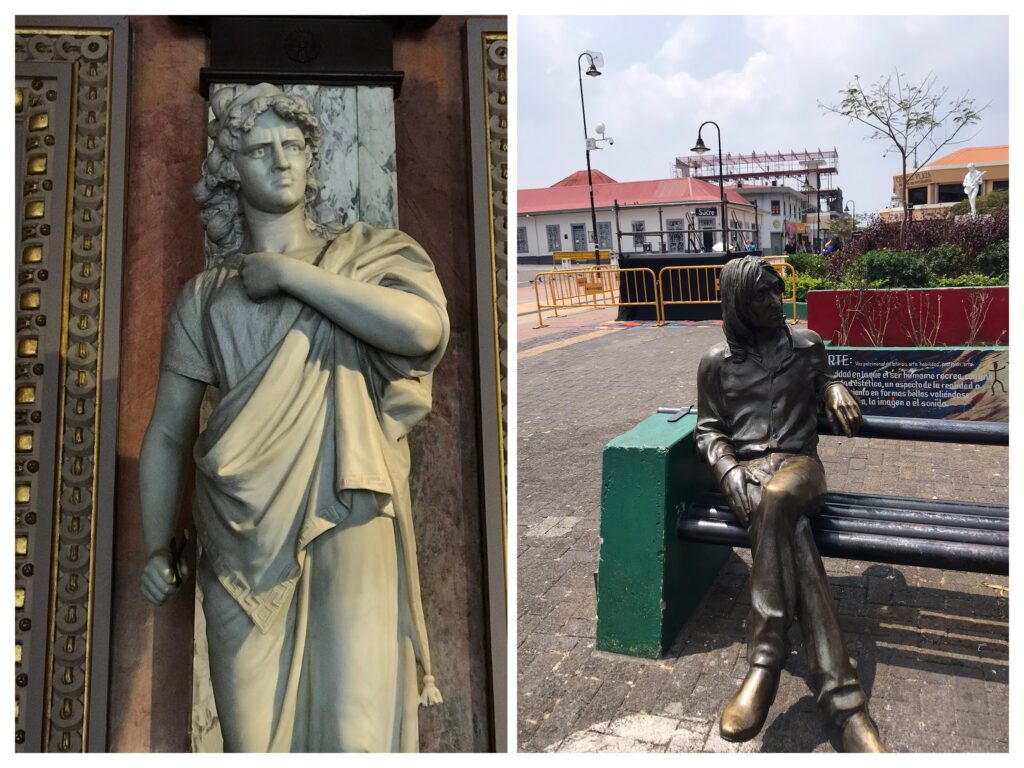
A slightly angry neo-classical sculpture and John Lennon cast in bronze, San Jose
There are several highly-rated museums in the centre of San Jose, including the Gold Museum, Jade Museum and the Museum of Costa Roca. Unfortunately we visited San Jose over the Easter period and all of these museums were closed!
La Fortuna
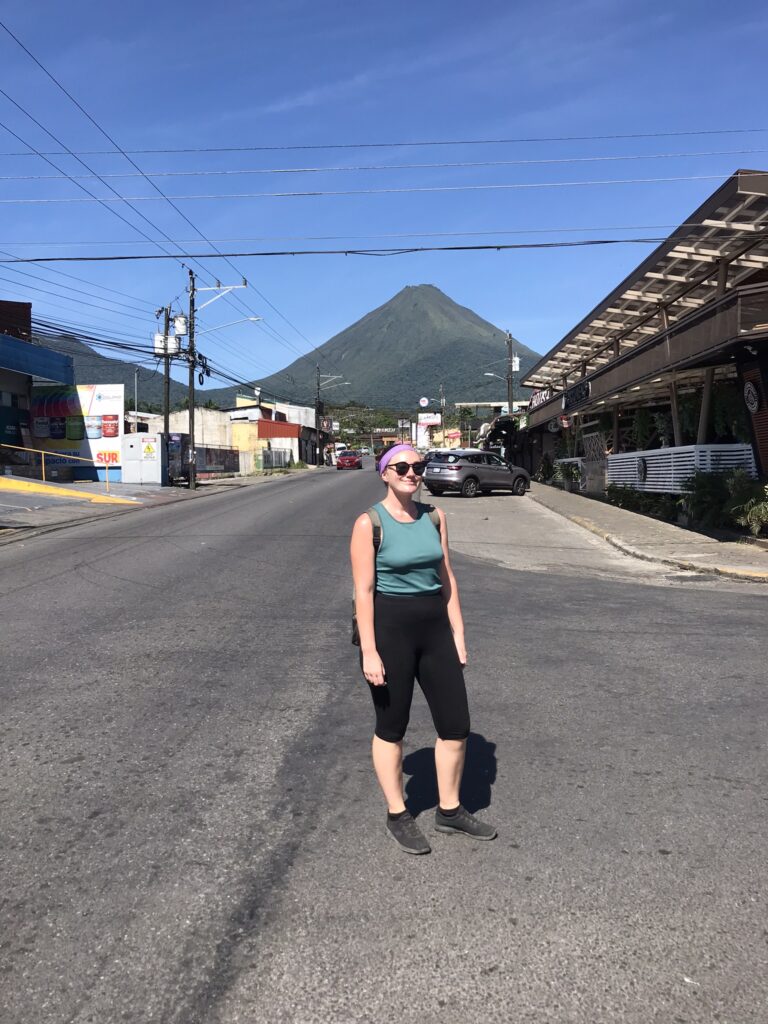
La Fortuna lies in the shadow of Arenal volcano; wherever you are in the town you can look over your shoulder and spot Arenal to the west. On some days all you can see is the mysterious outline of the volcano vanishing amongst cloud cover, but on a clear day you can see the perfectly-conical volcano rising up just outside the town limits. If someone asked a child to draw a volcano, Arenal is exactly what the child would draw, from its wide base up to its smoking spout.
Arenal Volcano was continuously erupting between 1968 to 2010, spewing red-hot lava and projectiles from its peak. Since 2010, the volcano has been classed as dormant but some volcanic activity can still be witnessed in the smoke rising from the summit. You can even experience the volcanic activity first-hand by taking a dip in the nearby hot springs, heated by the geothermal energy. Arenal volcano is now off-limits for hiking; there is currently a 4km exclusion zone in place around the volcano, established in 1998, to prevent injuries from falling ash, landslides, toxic fumes and plummeting rock missiles. Before this date, tour groups used to be able to visit the volcanic crater but authorities acted quickly after some tourists were injured and stopped this from happening.
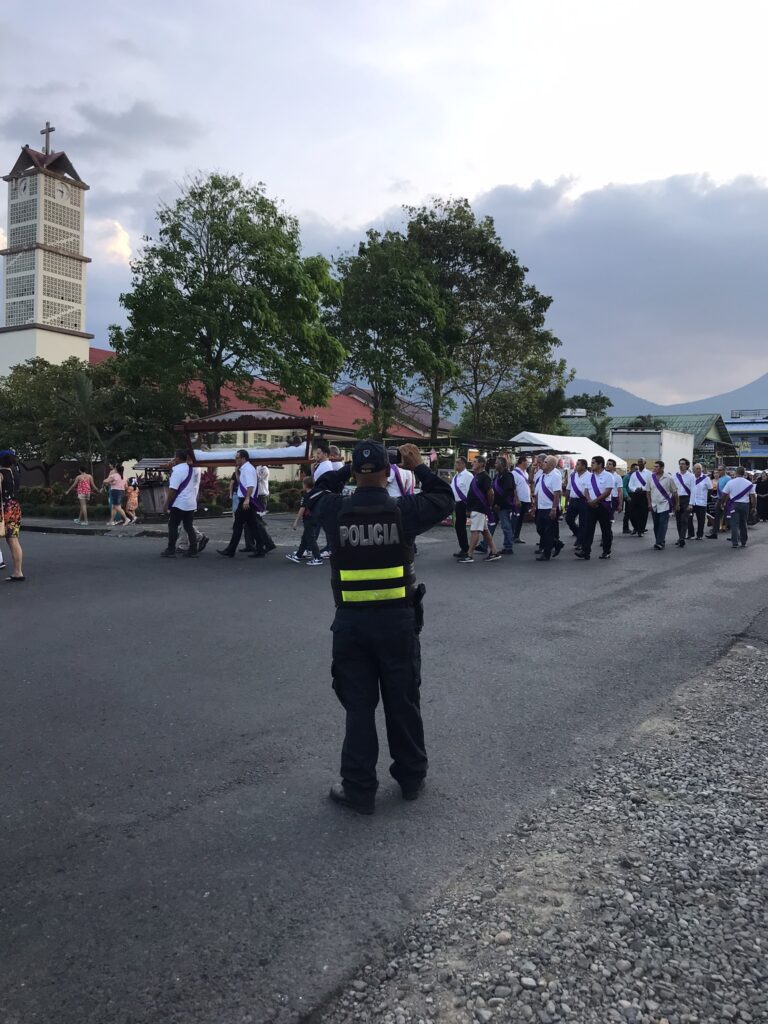
Watching the Easter Sunday parade from a safe distance
The town of La Fortuna itself is pretty compact with most restaurants, shops and tour agencies concentrated around the main park, unoriginally named Parque La Fortuna, and along the 142 highway. Apart from people-watching in the park and taking a peek inside the Catholic church, there isn’t a whole lot to do in town. The park has plenty of benches for resting on, ample green grass to eat a picnic and trees that come alive with the sound of hundreds of birds at dusk. Most of the luxurious eco-resorts are located out of town, promising serenity, tranquillity and isolation for a hefty price tag. All the major attractions in the region are out of walking distance from the town centre unfortunately, however Uber works well here. No matter where you stay, in La Fortuna town or further afield, you’ll have to take an Uber, book a tour or hire a car to get around.
Accommodation
Sleeping Mountain Arenal – perched above souvenir shops on the second floor, this small hostel with 6 rooms is very centrally located, overlooking the Catholic church in the main square. It’s a great option for budget travellers as it’s cheap, with a fantastic shared kitchen and nice balcony area. Do bear in mind that most tourists visiting Costa Rica tend to get up early to make the most of their holiday so expect banging in the kitchen from 7am. We got particularly annoyed with someone using a juicer at 6:30am right next to our room.
Foodie Places
Chocolate Fusión – This place has many facets: chocolate shop, bakery, café and ice-cream dispensary. We couldn’t resist going inside this shop just to ogle the chocolate counter (the truffles looked irresistible) and inhale the smell of roasting cacao and melted chocolate. It always seemed very busy which is a good sign. We treated ourselves to an ice-cream which was superb. The portion size was very generous and I was positively surprised at the price, it wasn’t as much as I’d expected, only around $5 for two small tubs.

La Fortuna park is ideal place to bring a picnic or eat ice-cream
Soda Melania – Sadly, I wasn’t a fan of Soda Melania. Maybe I was just unlucky with my meal choice, I’m not sure. After ordering a carbonara which I thought was a safe option, I was put off by the taste of the pasta which I can only describe as being similar to instant noodles.
El Río – better than Soda Melania by a mile. The place was so busy at times that there weren’t any chairs available. We found the price to quality ratio was much better here than elsewhere.
Musmanni La Fortuna – a popular bakery chain in Costa Rica offering bread, empanadas with various fillings, strudels, doughnuts and other typical baked goods. The ideal place to stop for lunch if you want to avoid expensive eating at restaurants. There is seating inside the bakery so you can sit down and enjoy your carb-filled lunch.
Activities
Chocolate & Coffee Tour with Don Juan – I can’t personally attest to what this activity was like as we booked it for Dan’s dad. However he seemed happy with the overall experience and came back with some homemade, slightly grotesque-looking, chocolate for us to try.
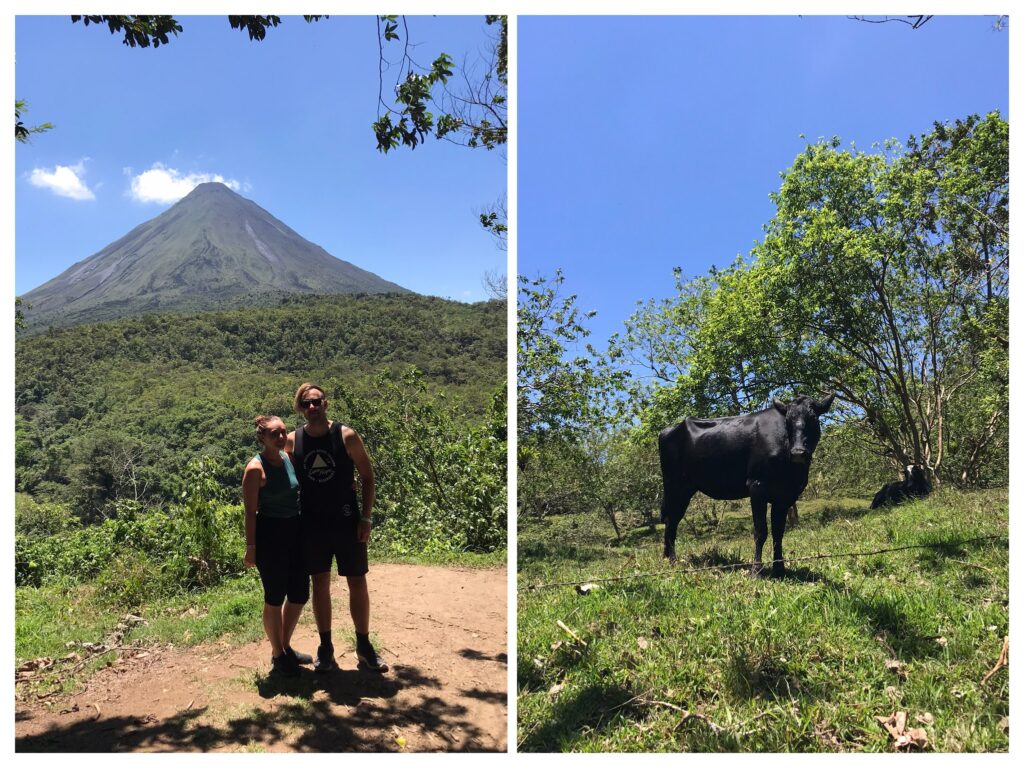
El Silencio was anything but quiet with the Howler monkeys
Hike at El Silencio – El Silencio is a park with a number of walking trails at the foothills of Arenal volcano, about as close as you can get to the exclusion zone. We decided to choose El Silencio rather than Arenal Volcano National Park as the $10 entry fee was more affordable and it also has a reputation of being less crowded than Arenal Park. In all honesty we spotted more cows than exotic animals on our trek here, however we did hear some Howler monkeys. You can just about get a glimpse of Arenal Lake and walk on the 1968 lava flow, which is now hardened volcanic rock. The park includes both forested areas, ideal for spotting animals, and cattle pastures with fantastic views over Arenal Volcano. A great choice if you want to stretch your legs, encounter some wildlife and get close to the lava field. The park entrance centre has free wifi so it is easy to arrange an Uber.
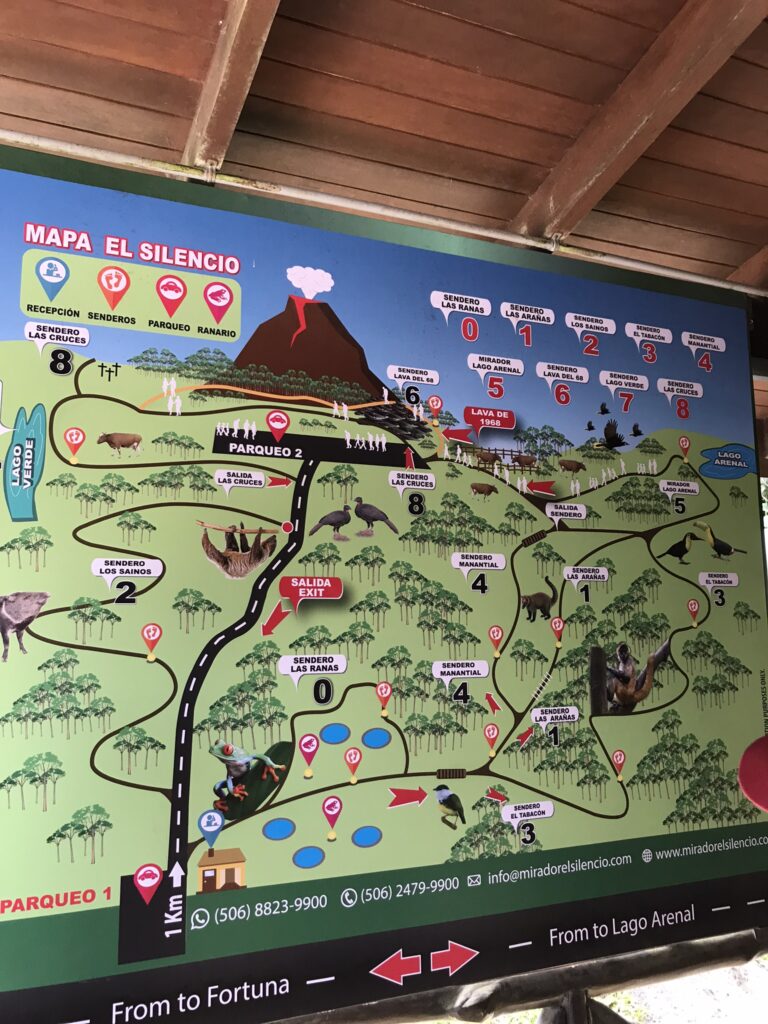
El Silencio map with hiking trails
Mistico Hanging Bridges – A privately-owned ecotourism project featuring 16 hanging bridges and Blue Morpho Waterfall. The bridges vary in length and height. We found this park wasn’t as large as the other parks we visited with less walking trails. On our 2-hour guided tour we managed to walk around the whole park at a slow pace, often stopping to observe any animals spotted. Bring your own snacks with you as the café is very expensive.
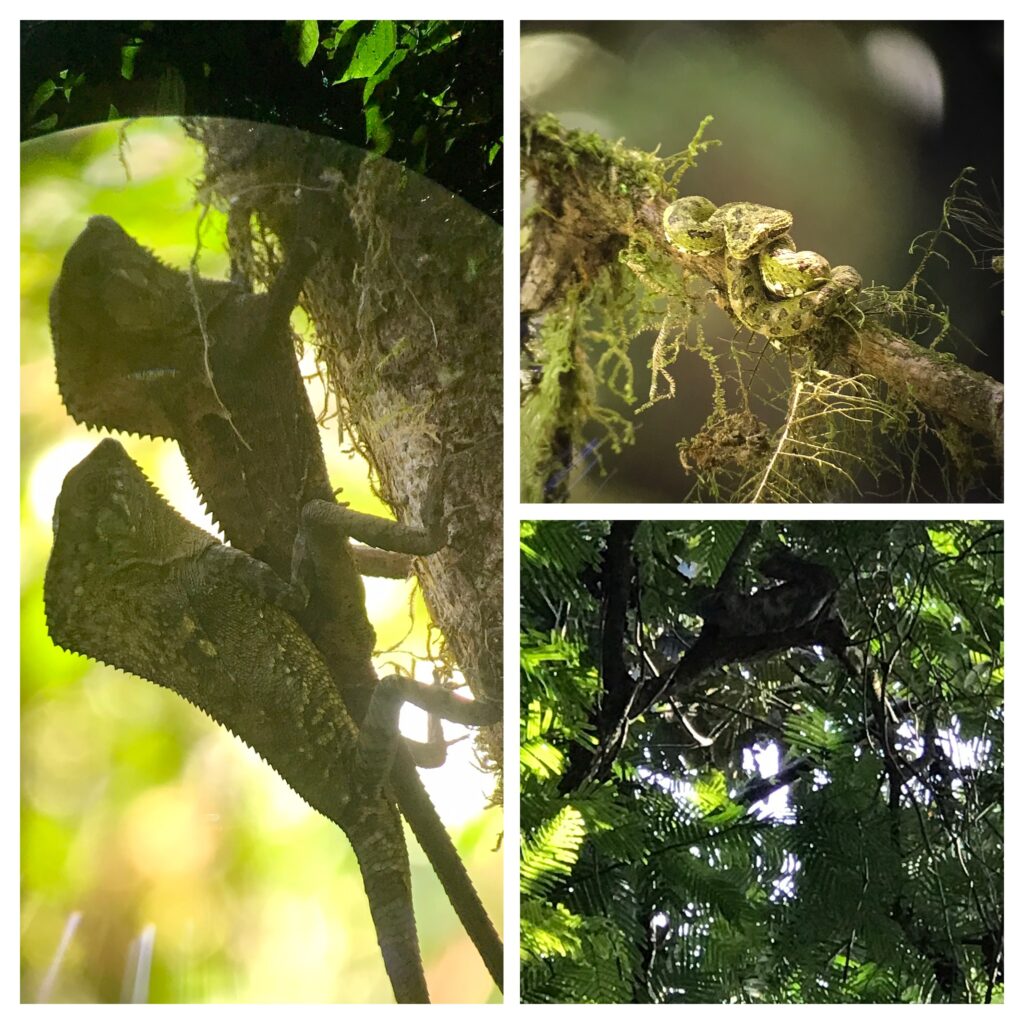
Most of the sloths (bottom right) you’ll spot will be asleep and just look like dark shapes nestled in the trees. The mating basilisks (left) were pretty cool and the snake (top right) was so well camouflaged I could barely see it without the telescope.
Bogarin Sloth Trail – If seeing a sloth is on your bucket list, Bogarin Sloth Trail is one of two options within walking distance of La Fortuna which almost guarantee a sloth sighting. The other one being ‘Sloth Watching Trail’, which is next door to Bogarin Sloth Trail. We picked Bogarin over the Sloth Watching Trail as we wanted to walk the trails freely rather than with a guided tour and that wasn’t possible with the Sloth Watching Trail. At Bogarin, you can either choose a guide or go by yourself, it’s totally up to you. You don’t need to book in advance if you decide to go without a guide. Due to the astronomical prices in Costa Rica, we opted to save some money and see if we could spot a sloth without the assistance of a professional sloth spotter. We were successful and did see a sloth, but it was purely down to luck rather than skill on our part. If you’re dying for a coffee or snack to keep your energy levels up, look no further than the on-site café which serves gourmet coffee and light meals.
Jeep-boat-jeep transfer with Caribe from La Fortuna to Monteverde – I’ve classified this as an activity rather than just a transfer as it included a boat trip on Lake Arenal. If you’re heading to Monteverde after La Fortuna and want to squeeze in an extra activity enroute, the jeep-boat-jeep transfer is perfect for you. This boat journey was an unexpected delight with stunning vistas over the towering volcano and pristine shores of the lake. Fancy lake-side houses were noticeably absent from this scene. Watching the shoreline whizz past you can almost imagine what the world would look like with no destructive humans, just nature abound. It was slightly strange when we docked as there wasn’t any pier or building in sight. We just had to wait on a dirt track for the next minivan to drop off tourists heading back to La Fortuna from Monteverde and then climb aboard. The roads between the dock and Monteverde were quite windy and just a little stomach-churning.
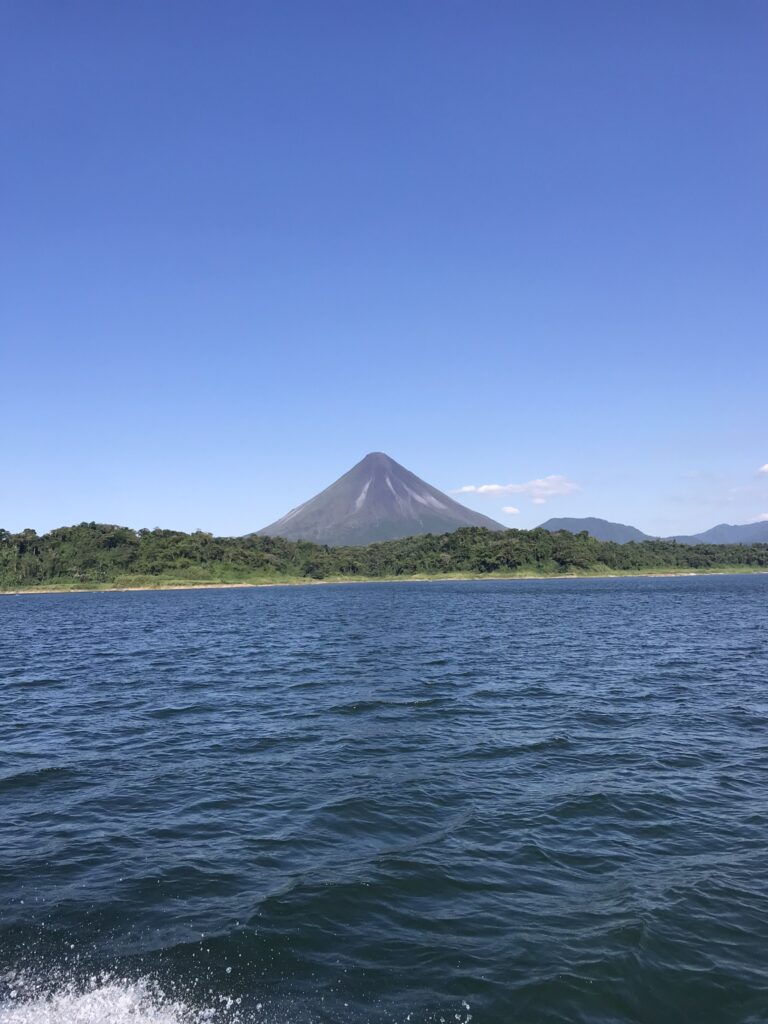
Lake Arenal and Arenal Volcano
Other popular La Fortuna activities include the hot water springs, free or as part of a spa complex, horse-riding, white-water rafting and zip-lining in the canopy.
My La Fortuna content is now available on GPSmyCity!
Monteverde
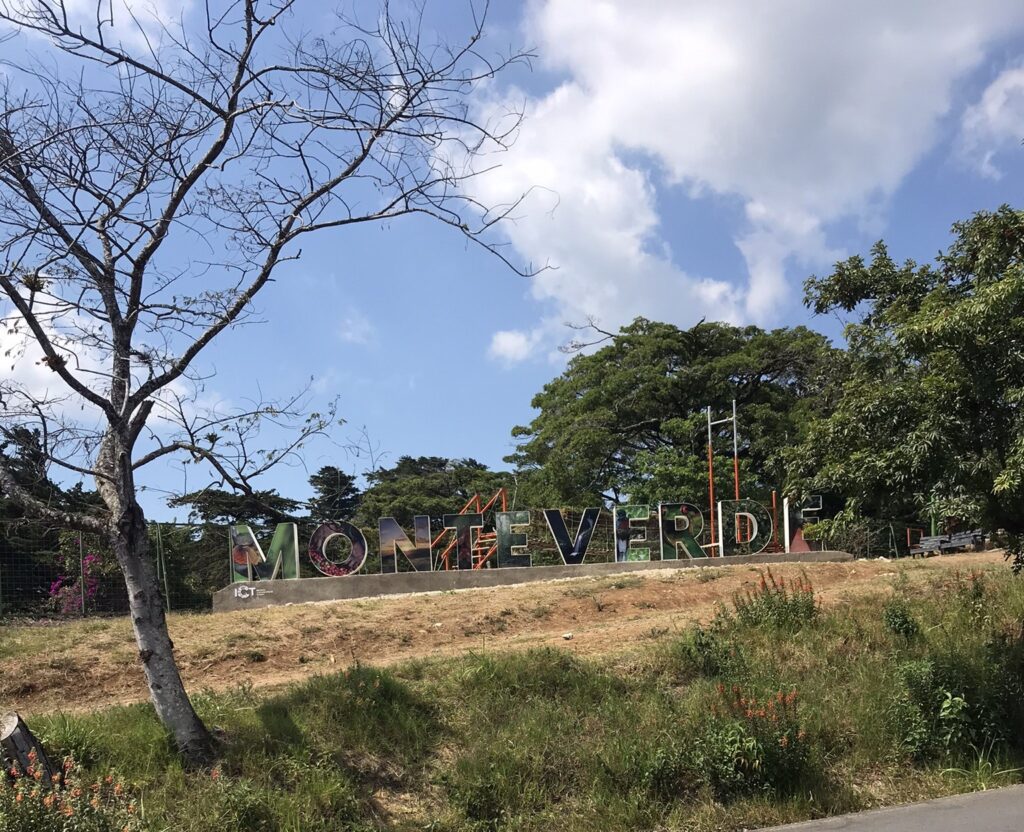
Most people visiting Monteverde are likely to actually stay in or near to the town of Santa Elena. This area is home to more popular national parks and cloud forests. Santa Elena is located in the mountains and has a cooler climate than La Fortuna and coastal areas. We found it again to be a very touristic place, with many hotels, hostels and restaurants catering mostly for tourists.
Plan how you’re going to get to Monteverde Cloud Forest, Santa Elena Reserve or other nearby attractions as Uber doesn’t work here. You can either take a taxi or a shared shuttle, most hotels and hostels should be able to arrange this for you. The shared shuttle is cheaper than getting a taxi, but you are slightly limited by the set departure and return times. The shuttle usually leaves Santa Elena town every hour or so but it’s best to double check these times with your hotel/hostel. Shuttle transport does need to be arranged in advance, ideally the night before and not 5 minutes beforehand.
Accommodation
Cottage Private Ensuite #2 on Booking.com – this quaint little one-bedroom bungalow, slightly outside the town centre but within easy walking distance of restaurants and supermarkets, was the perfect place to rest after a long day hiking the trails at Monteverde Cloud Forest. With its own functional kitchen and dining table, we made use of the place to host a family dinner with Dan’s dad. The nearby area is residential so no annoying disturbances during the night or eager travellers making noise early in the morning.
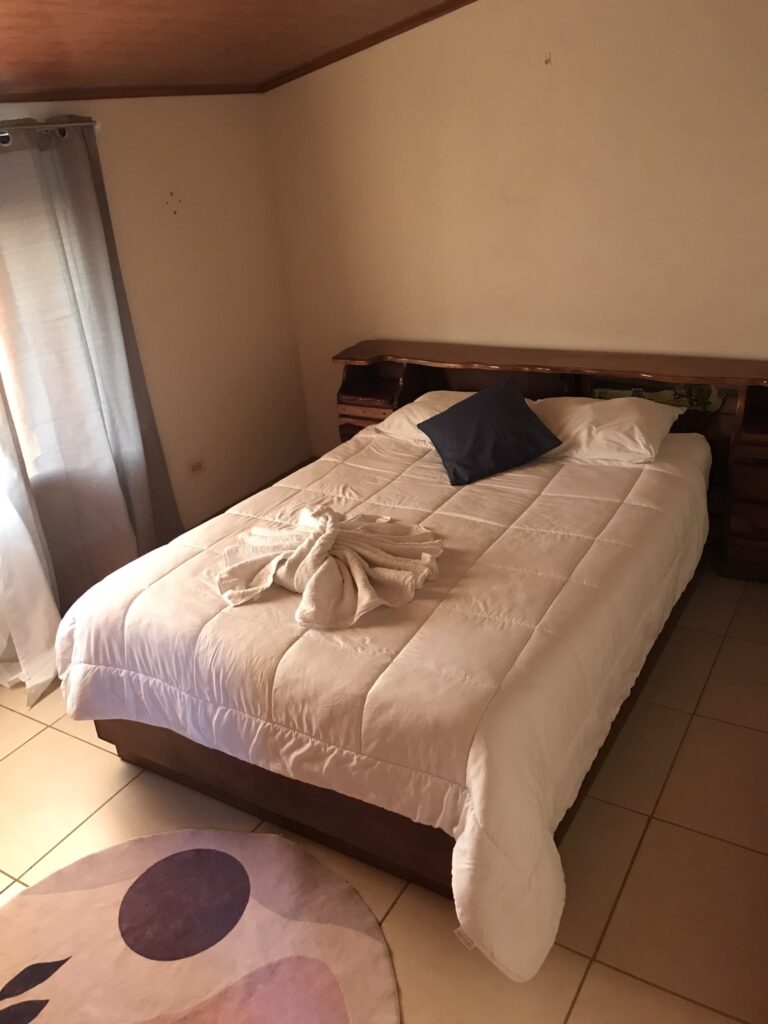
Our bungalow in Santa Elena was comfortable and affordable
Foodie Places
Jimenes Bakery & Coffee Shop – a bustling little bakery/coffee shop serving up freshly baked treats and savoury delights. A great pit stop if you’re looking for an inexpensive lunch in the town centre of Santa Elena.
The Open Kitchen – a more upmarket restaurant than we’re used to, a bit on the pricey side but nice to visit as a treat. It serves gourmet international and Costa Rican cuisine
Activities
Monteverde Cloud Forest Biological Preserve – for this privately-owned nature park we booked our guide separately to the entrance tickets, through Viator. One of the highlights of the park was the hummingbird sanctuary. We were blown away by how many different types of hummingbird congregate around the sugar-water bird feeders. They were so tiny and their wings flapped so quickly that they were almost invisible. On the guided tour we were lucky enough to spot a quetzal, these magnificent iridescent green birds are the national bird of Guatemala and the Guatemalan currency was named after them. They can be identified by their long tail feather and vibrant colour. Very few quetzals now exist in the wild, so seeing them was a real treat. After the guided tour, we followed the trails to the only hanging bridge in the park and lapped up the phenomenal views of the continental divide and lush, unspoilt rainforest carpeting the forest floor below the observatory lookout.
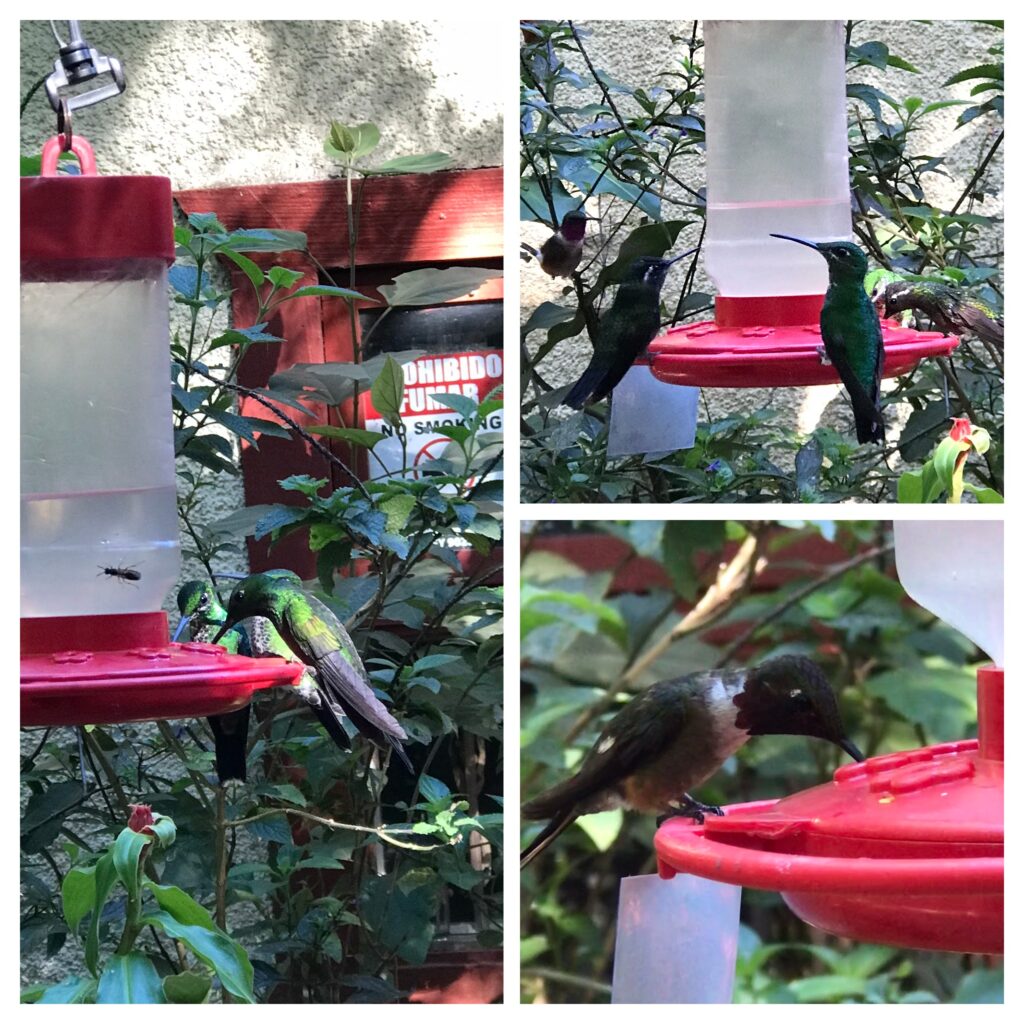
It’s best to visit the Hummingbird sanctuary early in the morning, around 7am, when the park opens to avoid the crowds
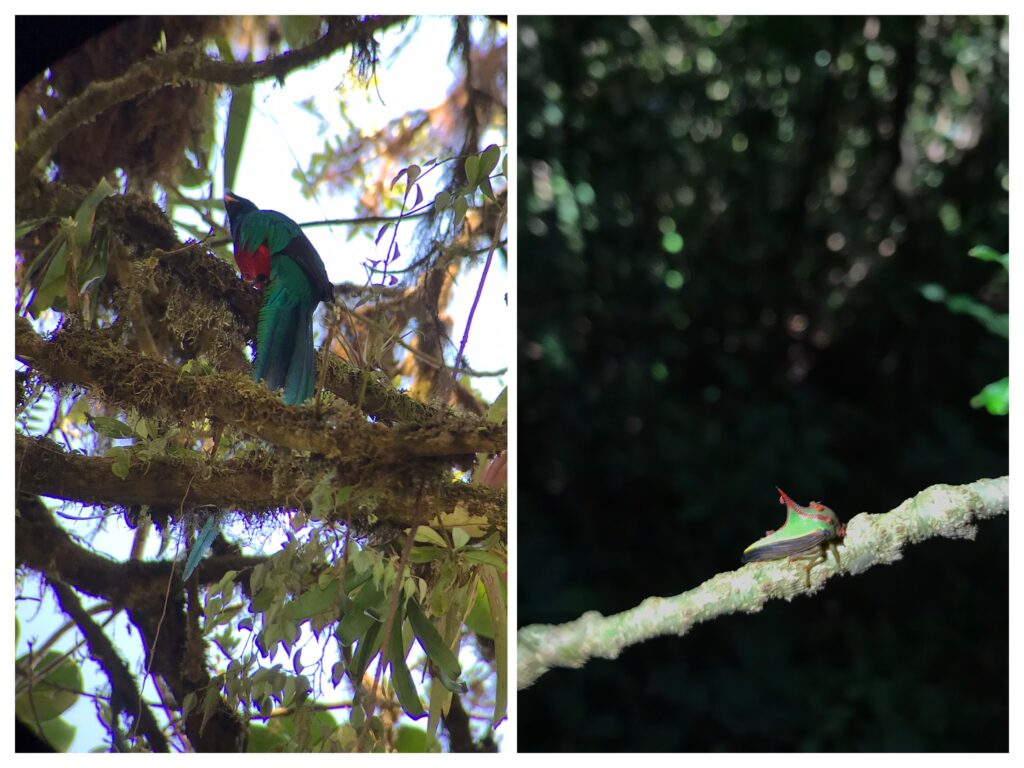
Whilst the coloured quetzal bird stands out, this bug completely blends in with the branch
Don Rodolfo Night Walk via Airbnb experiences – We knew we wanted to go on a tour after sunset as a lot of interesting animals are nocturnal and so cannot be seen in the national parks during the day. After much research we settled on Don Rodolfo as it was highly rated online. Whilst we didn’t see as many animals as we’d hoped, we definitely weren’t disappointed to see a pygmy frog, armadillo, a tarantula, many sleeping birds (I’d never really thought about birds sleeping until this tour), a sloth and the scent of the nearby puma (really stinky by the way). Torches are provided so you don’t need to bring one with you. If you book this tour make sure you have a way to get back to Santa Elena; we didn’t and someone from Don Rodolfo had to call a taxi for us. It’s possible to walk to Don Rodolfo from Santa Elena town centre during daylight hours but not in the dark after the tour as the road is steep and uneven.
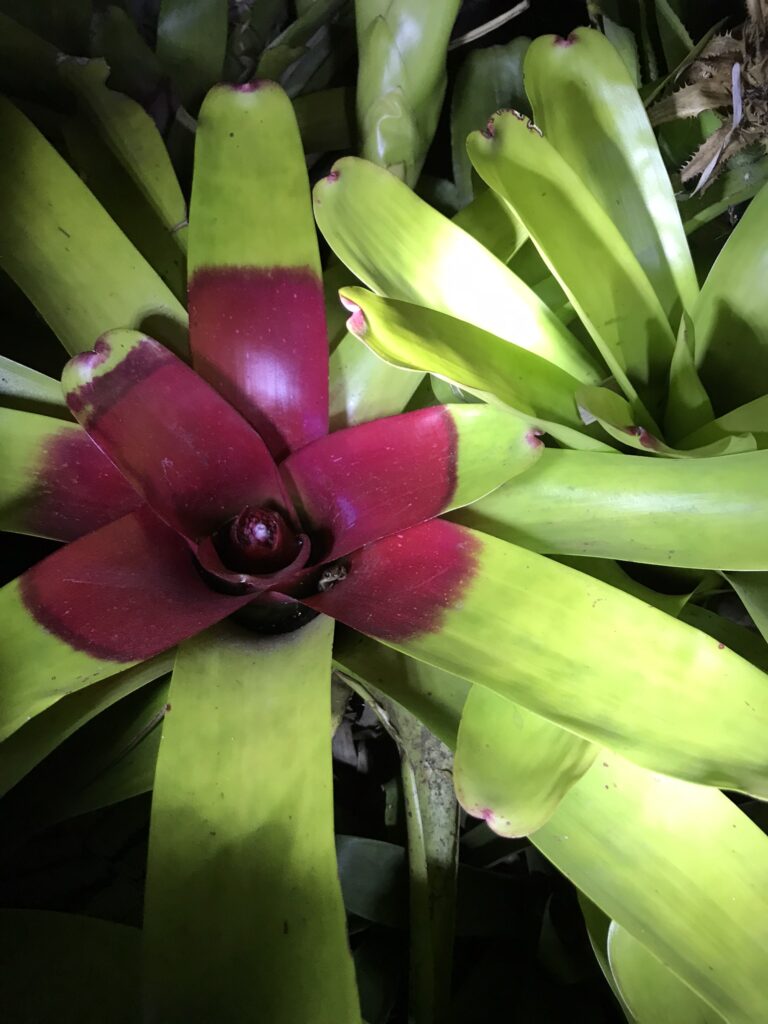
If you look very closely you can see a pygmy frog nestled in the centre of the plant
Santa Elena Reserve is a community administered reserve close to the town of Santa Elena. It’s not technically a national park, but under the protection of the Arenal Conservation Area. The place is packed with nature trails, it’s possible to spend a whole day wandering around the paths and keeping an eye out for any elusive birds and animals. There’s a café close to the visitor centre in case you want to grab lunch without leaving the park. The sandwiches are, almost unbelievably, a very reasonable price when compared to other national park cafes (like that at Mistico Hanging Bridges park), which are madly extortionate.
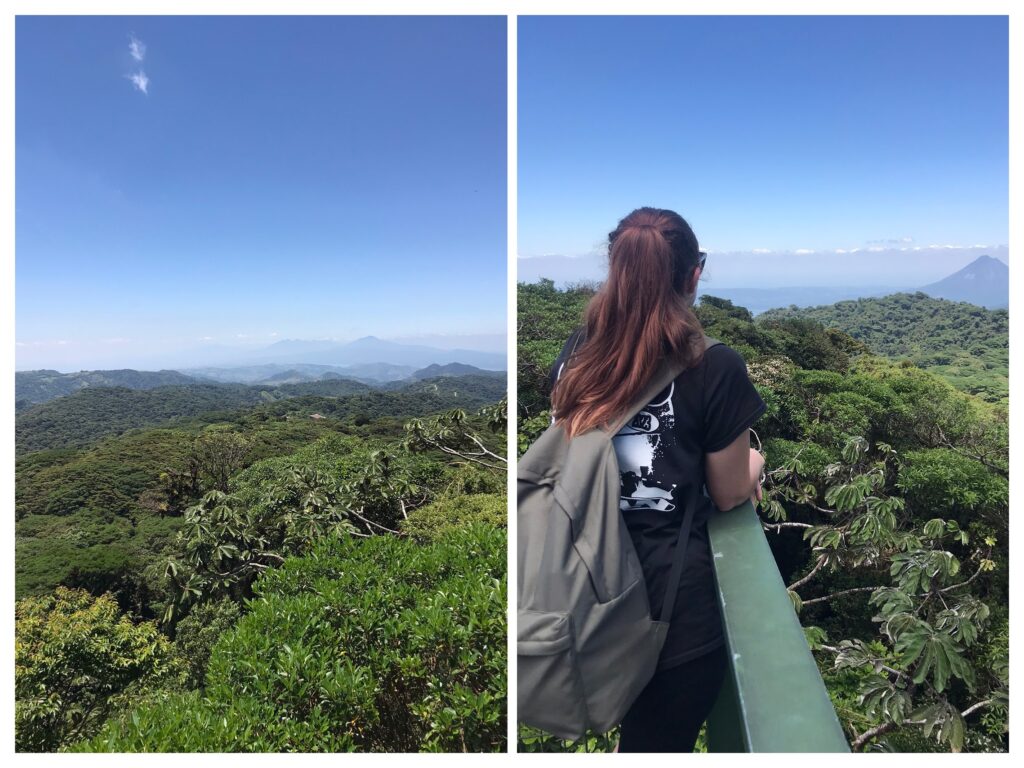
Head to the viewing platform at Santa Elena Reserve for the best views in the park. The lookout rises high above the canopy and provides views of the Arenal volcano as well as other distant volcanoes.
My Monteverde content is now available on GPSmyCity!
Quepos – Manuel Antonio
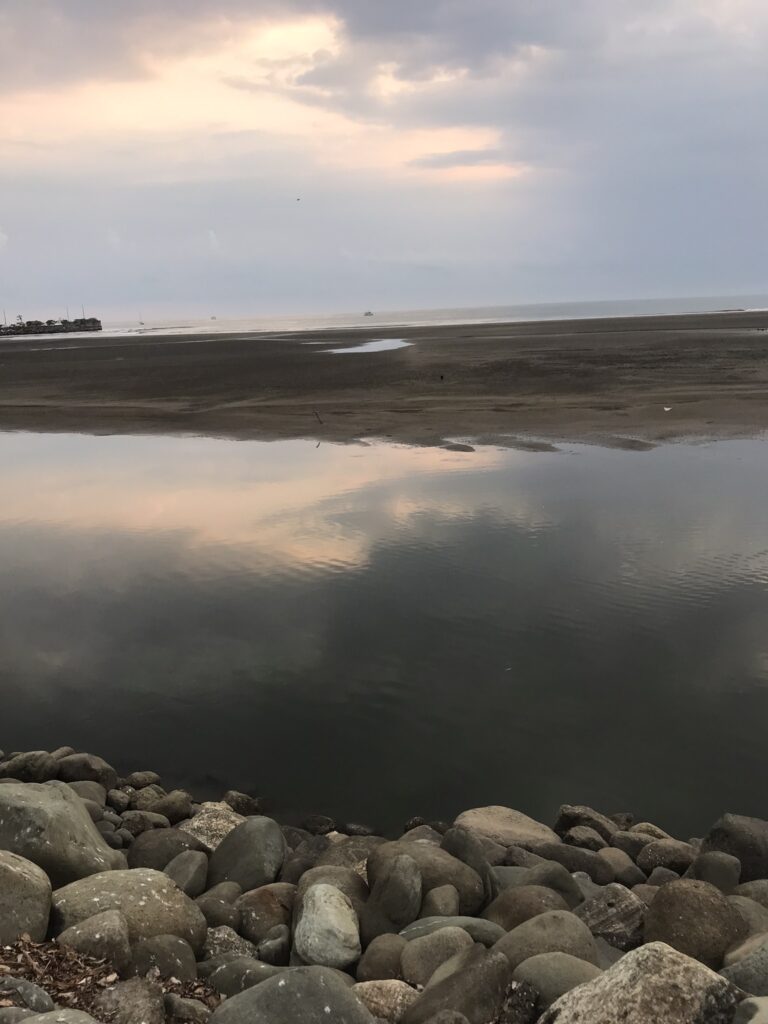
The view over the Quepos bay at sunset
Quepos is situated on the Pacific Coast of Costa Rica. It is known as the gateway to Manuel Antonio National Park which is about 7 km away from the centre of Quepos. The town of Quepos has a lot of tourist facilities but not a huge amount to see or do, while Manuel Antonio Park has mangroves, lagoons and immaculate rain-forest lined beaches hosting a multitude of monkey species such as howler, white-faced and squirrel monkeys.
Manuel Antonio National Park is closed on Tuesdays so take this into account when planning your itinerary. There is a bus every 15 minutes which leaves the bus station here and reaches Manuel Antonio National Park entrance roughly 25 minutes later. Please bear in mind this is a public bus that locals use to get to work, so take into account that it may take a little longer depending on the number of stops and passengers alighting. Keep an eye on the road when you’re in the bus as you may see some wildlife, we even spotted an anteater running across the road!
While it sits on the ocean, Quepos town doesn’t really have any accessible beaches. The best beaches in the area are at Manuel Antonio Park – there are beaches within the park, and a large public beach outside the park entrance. In my honest opinion, Espadilla South Beach inside Manuel Antonio Park is much nicer than Espadilla North Beach which is just outside the entrance to the park. The beaches inside the park are completely free of litter whereas North Beach is sadly less-well looked after litter-wise. The beach isn’t totally trashed but there’s a noticeable difference between the two. On the public beach, you might encounter the occasional hawker or waiter offering to bring cocktails to your sunbed in stark contrast to the private park beach. It’s great if you want this sort of service but we tend to avoid these interactions. I got the distinct feeling that some people visit Manuel Antonio Park just to go to the beach, bypassing the wildlife on the trails and heading straight for the sand, sun and sea for their beach-fix. This means that the beaches inside the park tend to be rammed with bikini-clad tourists, while the public beach isn’t as busy. It was almost impossible to find a shaded patch of sand to sit on the beach inside the park. There are pros and cons for both.
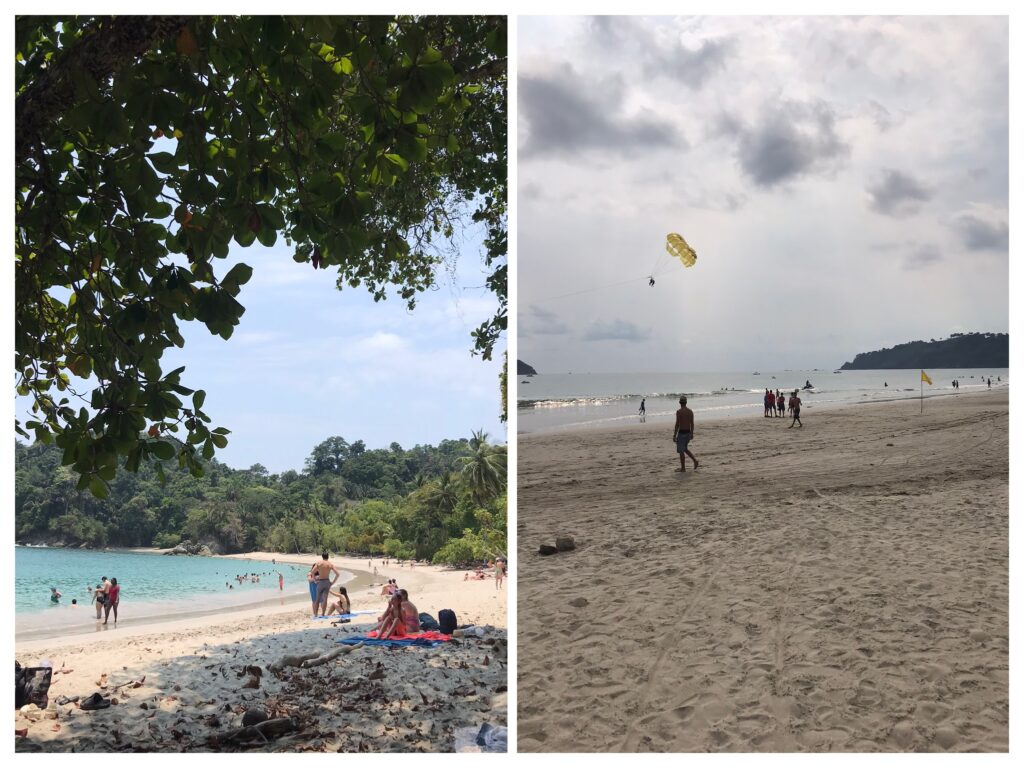
On the left is Espadilla South Beach located inside Manuel Antonio Park and on the right is the public beach: Espadilla North Beach
Accommodation
You can either stay in the town centre or at one of the hotels along the bus route to Manuel Antonio Park. It’s easy to move between Quepos town and Manuel Antonio Park entrance using the regular public buses.
Quepos Inn via Airbnb – located right across from the bay and only 1 block away from the bus station. Quepos Inn has two important features; these private-contained flats include a kitchen and, crucially for us, air-conditioning. We managed to knab a room at very late notice when another booking fell through. The check-in process was smooth and we didn’t have any issues.
Foodie Places
Unfortunately we didn’t splurge on any meals out here as we wanted to save money. We were able to cook some basic meals for a relatively cheap price using food from the supermarket in town.
Activities
Manuel Antonio Park – We had serious mixed feelings about this park. On one hand, the park had a huge amount of visible wildlife compared to all of the other parks we visited in Costa Rica. We saw a sloth, green jungle frog, wild deer, white-faced capuchin monkeys and toucans without a guide just by walking the path from the park entrance to the beach area. Manuel Antonio is a small park so maybe the wildlife is more apparent here, or maybe we just got lucky on the day.
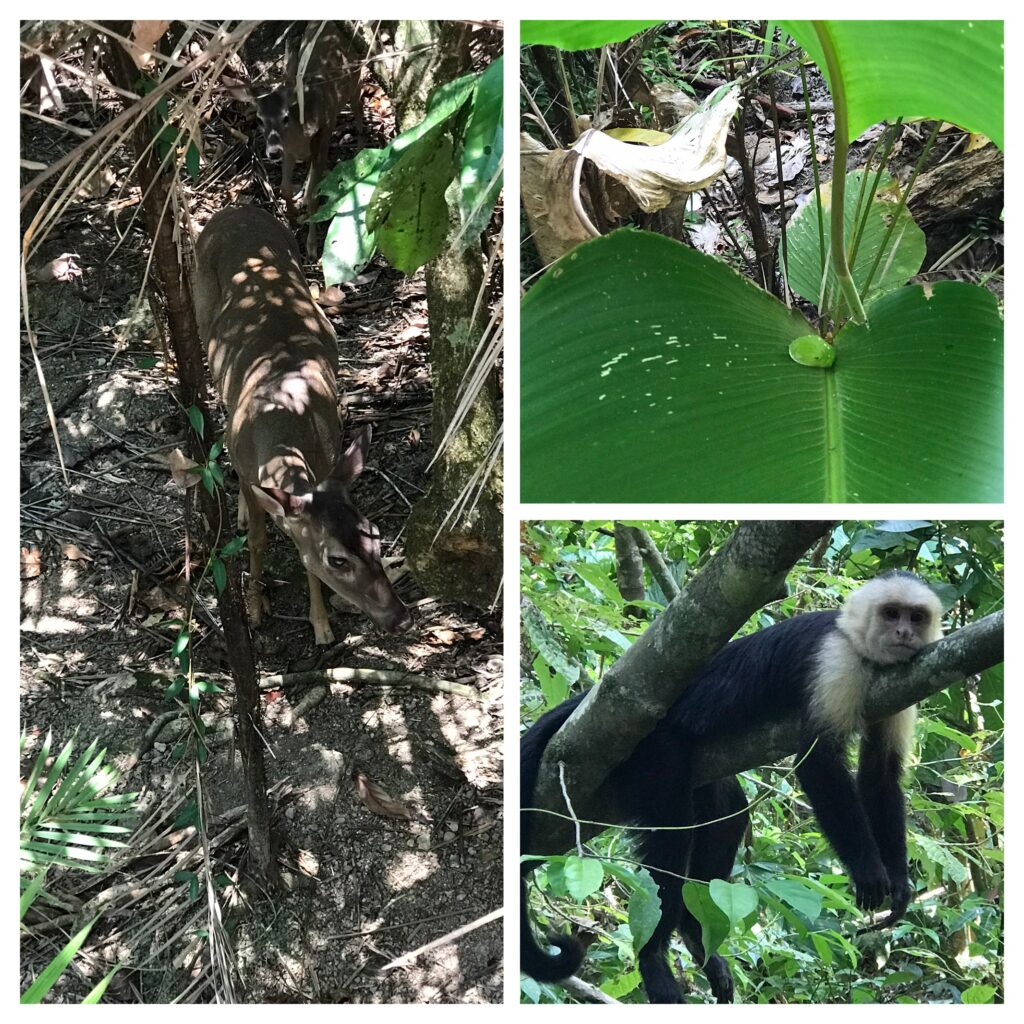
Manuel Antonio Park was a treasure trove of wildlife from white-faced capuchin monkeys to green jungle frogs and wild deer. Watch out for the cheeky monkeys who may try to grab your bag.
Apart from this, we really did not enjoy our time in Manuel Antonio Park. Despite strict visitor limits, we found that the park was overcrowded – you could barely move at points on the trails or on the beaches. The entrance to the park was also surrounded by hustlers and scammers, something we didn’t find at other parks in Costa Rica. Most importantly, we were prevented from taking a repurposed 2 litre Coca Cola bottle filled with water into the park, as the guards idiotically tried to tell us that it was single use plastic and tried to make us buy a new plastic ‘reusable’ bottle. Apart from the obvious incongruity of what they were proposing, confiscating water in 30+ degree heat really isn’t great at all and we were only able to spend about two hours in the park without water before needing to leave due to being overheated and dehydrated. We also were prevented from taking our prepared lunch into the park and were made to pay $5 to store it in a locker at the entrance. The staff at the entrance tried to claim that food and drink were prohibited for conservation purposes but, in our eyes, this was clearly a money-making ploy to try and force people to buy food and drinks from the overpriced café in the park. We didn’t experience this sort of thing at any other park that we visited in Costa Rica, and in Manuel Antonio we even saw parts of the trail littered with the (non-biodegradable) Coca-Cola drinks cups that were being used to serve drinks in the café. So much for conservation. Ultimately, despite its natural beauty and abundant wildlife, we really felt that this park was a tourist trap and came away frustrated with the experience.
Palmar Sur
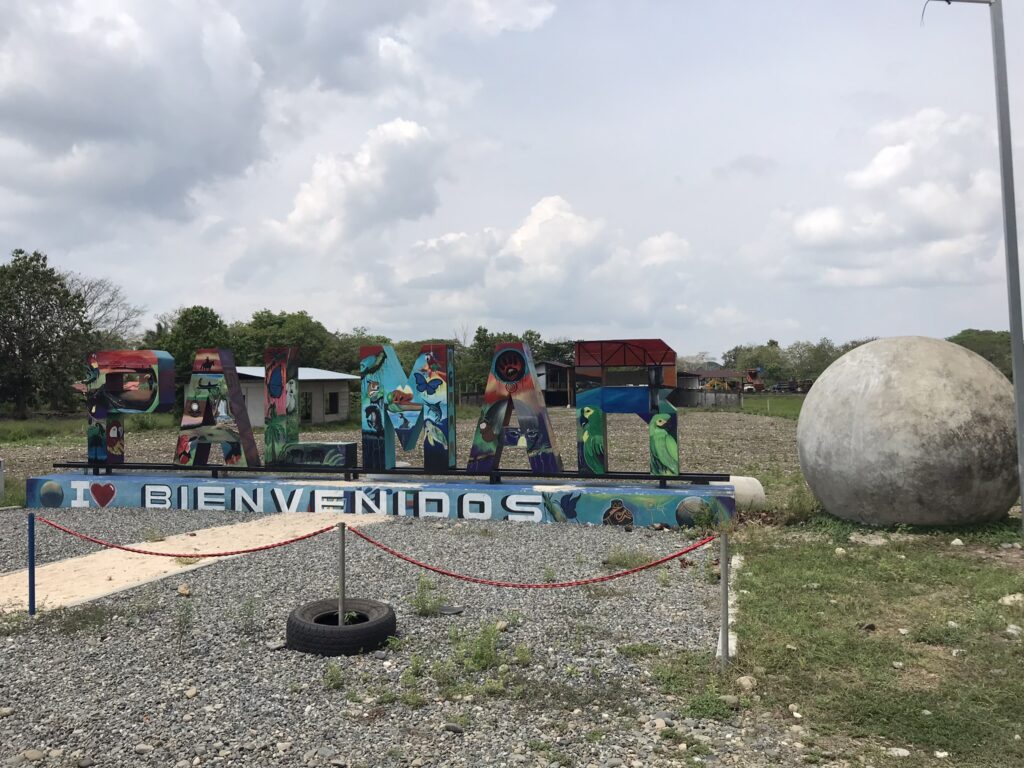
If you’re fed up with following the well-worn tourist trail in Costa Rica and looking for somewhere other tourists don’t go to, consider exploring the mysterious stone spheres at Palmar! These perfectly-spherical stone balls are between 500 and 1500 years old, the last vestiges of a thriving, complex civilisation based in the Diquís Delta. They have become a symbol of Costa Rica and remain the only cultural UNESCO World Heritage Site in the country. They are incredibly unique and distinctive. Much technical knowledge and understanding of their meaning and significance has been lost to time.
By this point of our Costa Rica leg we were pretty disillusioned with the tourist bubble, desperate to meet real people and experience the true Costa Rican life away from the tourist hordes. Our time in Palmar Sur was a great antidote to the overly touristic nature of the rest of the country.
Palmar Norte and Palmar Sur are twin towns linked by a large iron bridge over the river, and are accessible by bus en route to Panama. The bus station is in Palmar Norte, but it is possible to walk between the two. This place felt much more authentic than anywhere else we visited in Costa Rica.
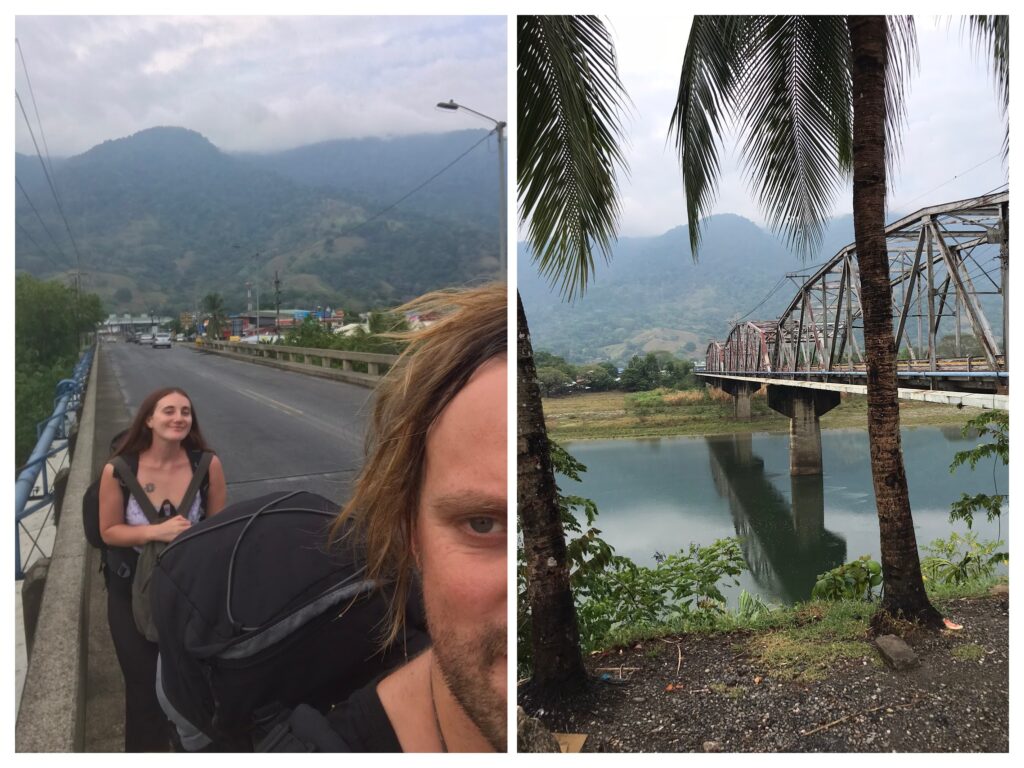
Traversing the bridge between Palmar Norte and Palmar Sur
Accommodation
La Muñequita Lodge – named after the owner’s wife, muñequita translates as little doll or dolly. Heyner, the owner of the farm and all-round nice guy, could often be heard calling his wife muñequita and busying himself with tasks around the farm. It was impossible not to like Heyner with his great sense of humor and warm charisma. Muñequita Lodge is made up of several rustic wooden cabins on the grounds of the farm, all with running water, electricity and plumbing. Breakfast is included in the price of the room and dinner is offered as an extra for a very reasonable price. Both meals are freshly prepared by Heyner’s wife and family. They are incredibly friendly and welcoming to guests, happy to share stories and help you plan your activities for the next day.
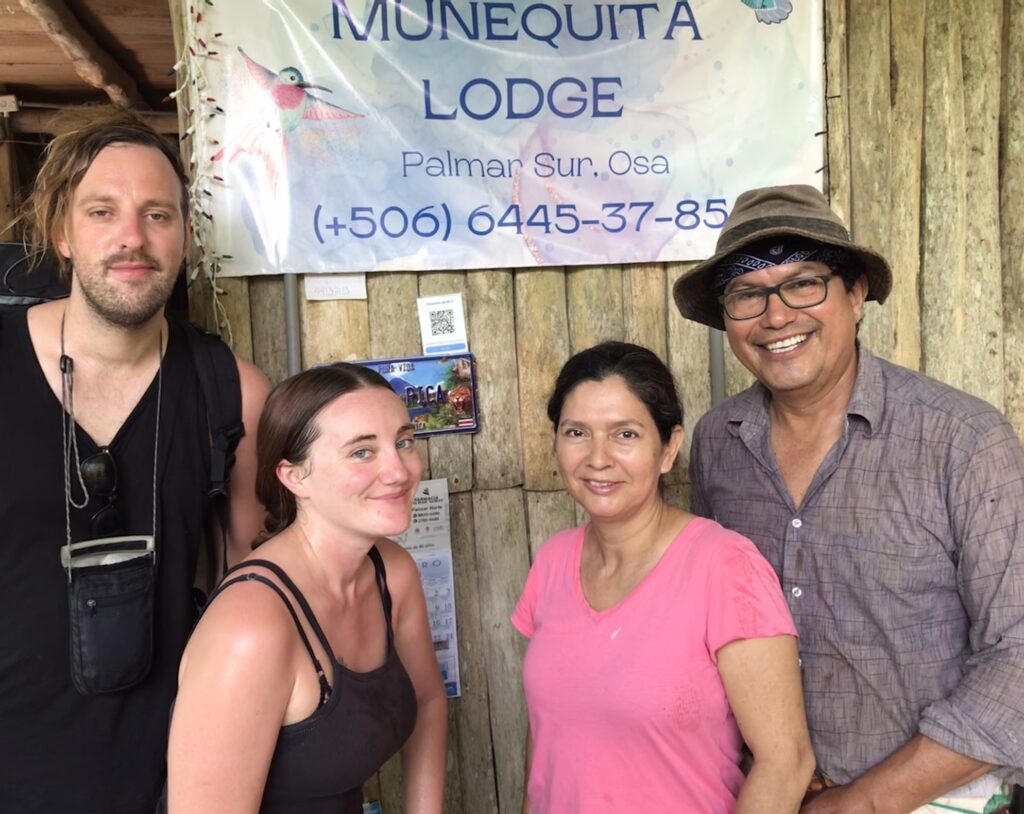
Just a tad sweaty at Muñequita Lodge
When it comes to the lodges, there are some gaps in the walls so expect to find some unwelcome insects and beetles. The beds are comfortable and supplied with mosquito nets and fans. The veranda was a great place to chill in a hammock, unwind and absorb the sounds of nature. Don’t be surprised to stumble upon a goat or rogue turkey in the garden as it’s still a fully functioning farm. It’s by no means a 5* hotel but it is an authentic experience living with a real Costa Rican family. We saw taxis speeding around Palmar Norte so it shouldn’t be a problem catching one if you don’t feel like walking all the way to Muñequita Lodge like us.
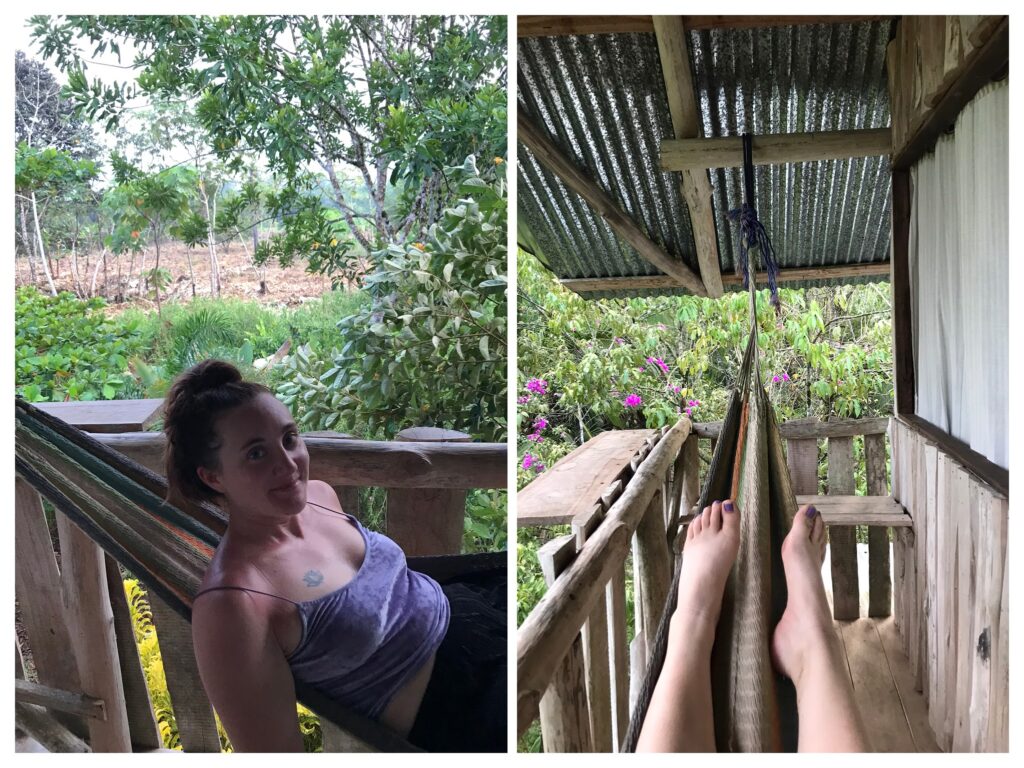
Testing out the hammock on the veranda at Muñequita Lodge
Foodie Places
Oasis El Cruce – a budget-friendly option with hamburgers, pasta and typical Costa Rican fare on the menu. No complaints from us.

Gorging on a hamburger at Oasis El Cruce
Activities
Parque de Las Esferas (Park of the Spheres) – this small public park in Palmar Sur displays some of the stone spheres found nearby. When we visited it was completely deserted without a single tourist in sight, hallelujah! There’s also an antique train complete with carriages nearby which is a great photo opportunity.
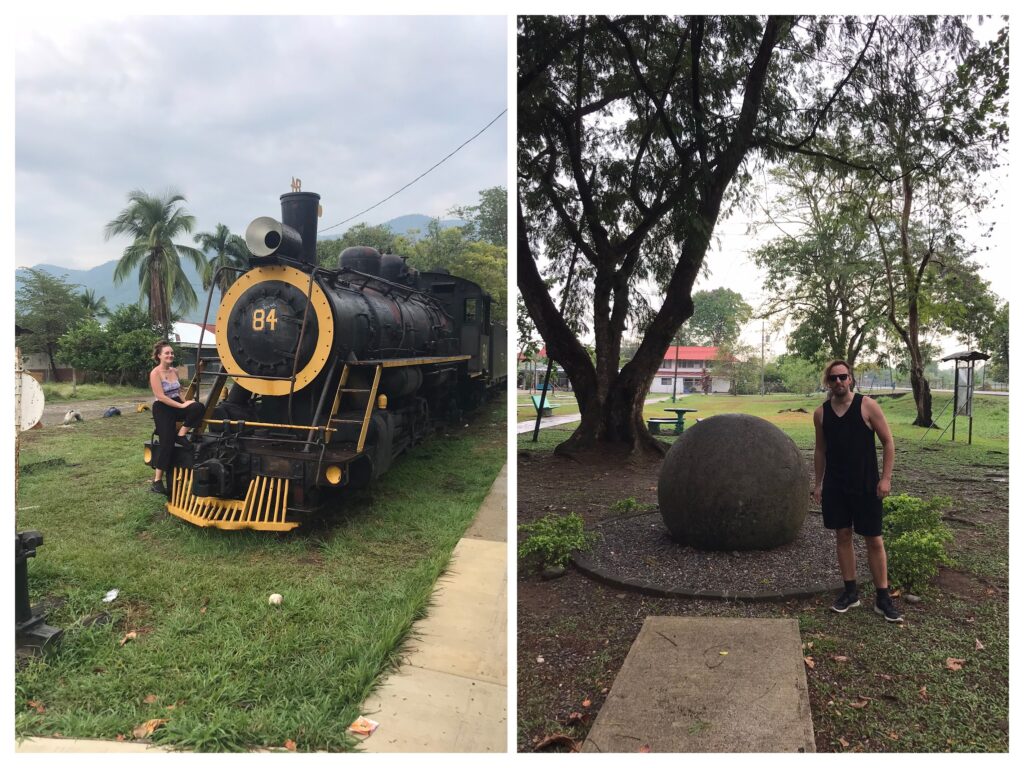
Taking a much needed pitstop at Parque de Las Esferas
Batambal Archeological Site – when you first step foot outside the gates, you could be forgiven for thinking the site is closed to the public as the gates may look like they are locked. Well, this isn’t the case! You simply have to slip through a small gap beside the gates and then you have the entire site to yourself. At your own leisure you can meander around the grounds, it’s not a huge complex so it won’t take very long and admire the craftsmanship of the spheres. The site has a great view over the river and surrounding landscape. There are also plaques which provide some information about the stones and the history of the area. We got a taxi here from Muñequita Lodge, however it is within walking distance of Palmar Norte. After visiting Batambal we walked back through the sleepy village and along the highway to the bus station in Palmar Norte in about 30 minutes.

Having a ball at Batambal Archaeological Site
There are more spheres at Finca 6, which is the larger and more established of the archeological sites making up the wider UNESCO site. We decided not to visit this site due to the logistics of getting there, it’s much further away from Palmar Norte than Batambal, impossible to visit without hiring a taxi and you had to pay an entry fee whereas Batambal is free to visit – a rarity for a World Heritage Site and especially in Costa Rica.
My Palmar Sur content is now available on GPSmyCity!
From Costa Rica we headed to Panama. Read about my experience crossing the border at Paso Canoas here!
